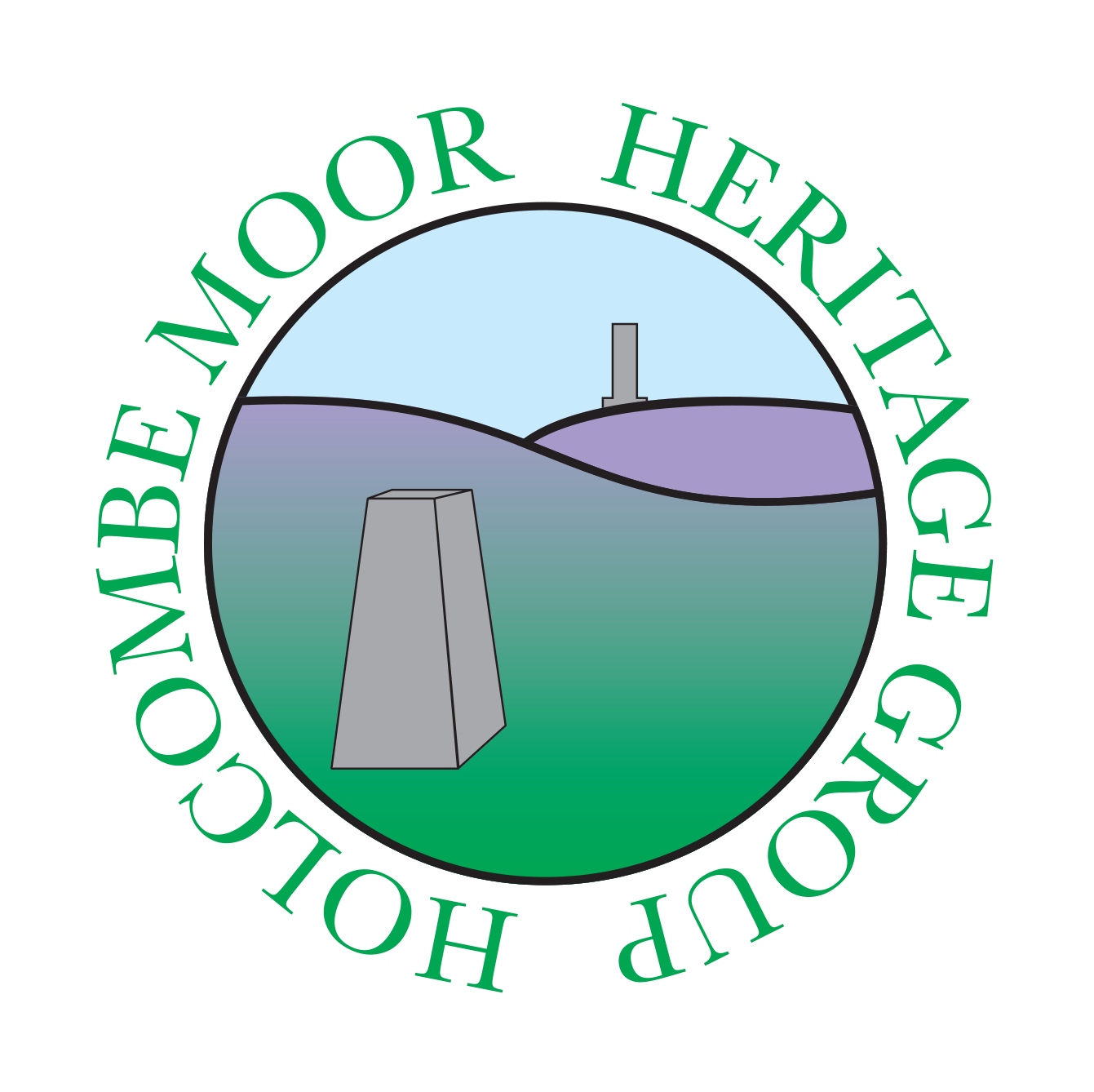

On Thursday 17th March the new extended layout for 2021’s trench 1 was laid in. As the new layout extended beyond the original 2021 trench fence boundary the fence had to be extended to the west and also to the east. As it took the whole of the day to carry out the modifications no archaeology was started.
Thursday 24th March 2022
The morning was spent de-turfing the newly extended areas of trench 1. During the afternoon work started on removing the topsoil from the new archaeology areas. The thickness of the topsoil on the west side is relatively shallow which will make accessing any archaeology fairly straight forward. Photo 24-3-1
The topsoil on the east side, although considerably thicker, is also easy to remove. Photo 24-3-2. Saturdays dig of the 26th March should see all the topsoil removed from both the west and east extensions.
There were a few small finds recovered during the days dig but, as they were all from the top soil, they were all probably brought in with soil utilised to cover the archaeology we are interested in when the field was returned to agriculture usage. Interesting items to look at but not of real interest in a historic aspect. Photo 24-3-3
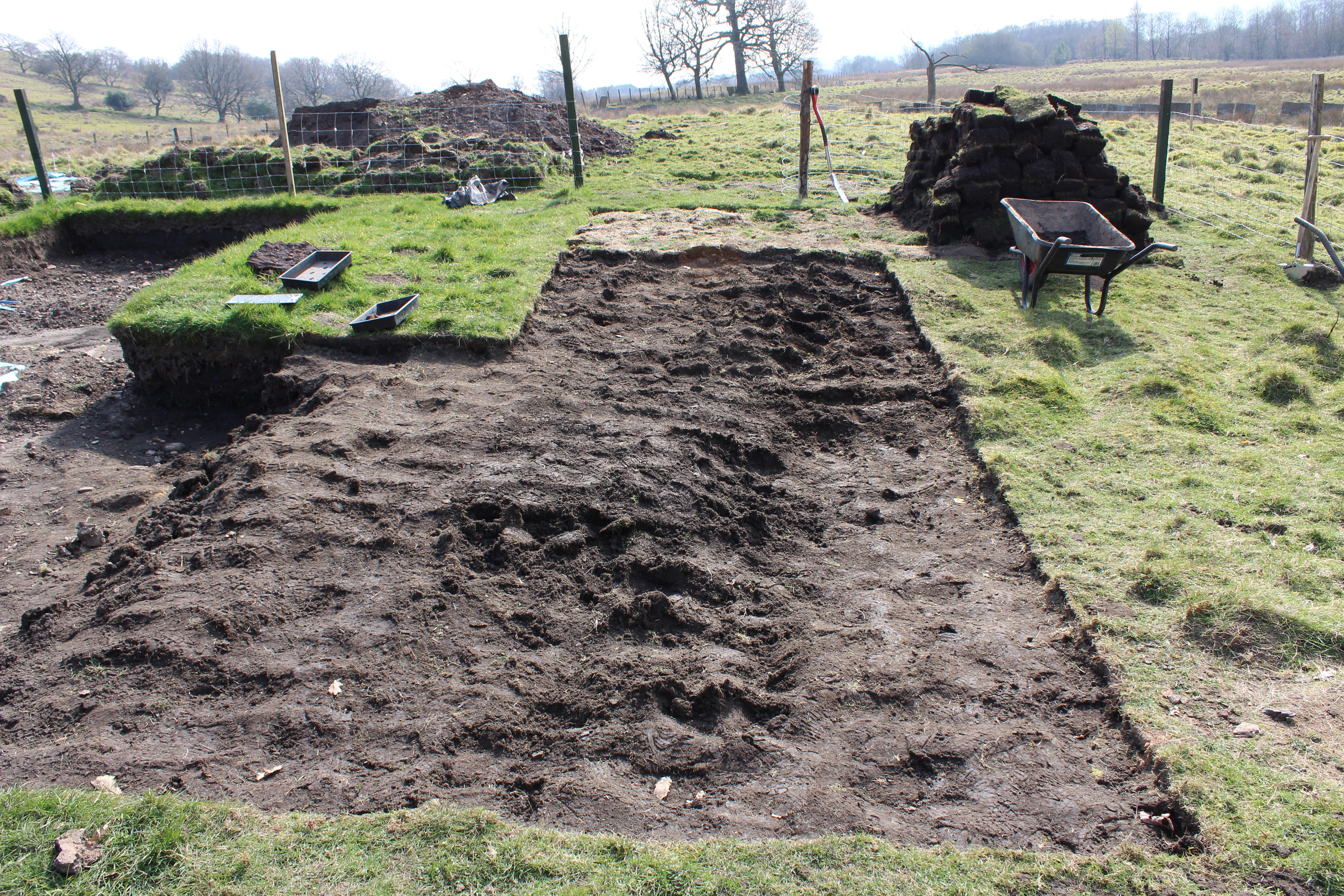
24.3.1
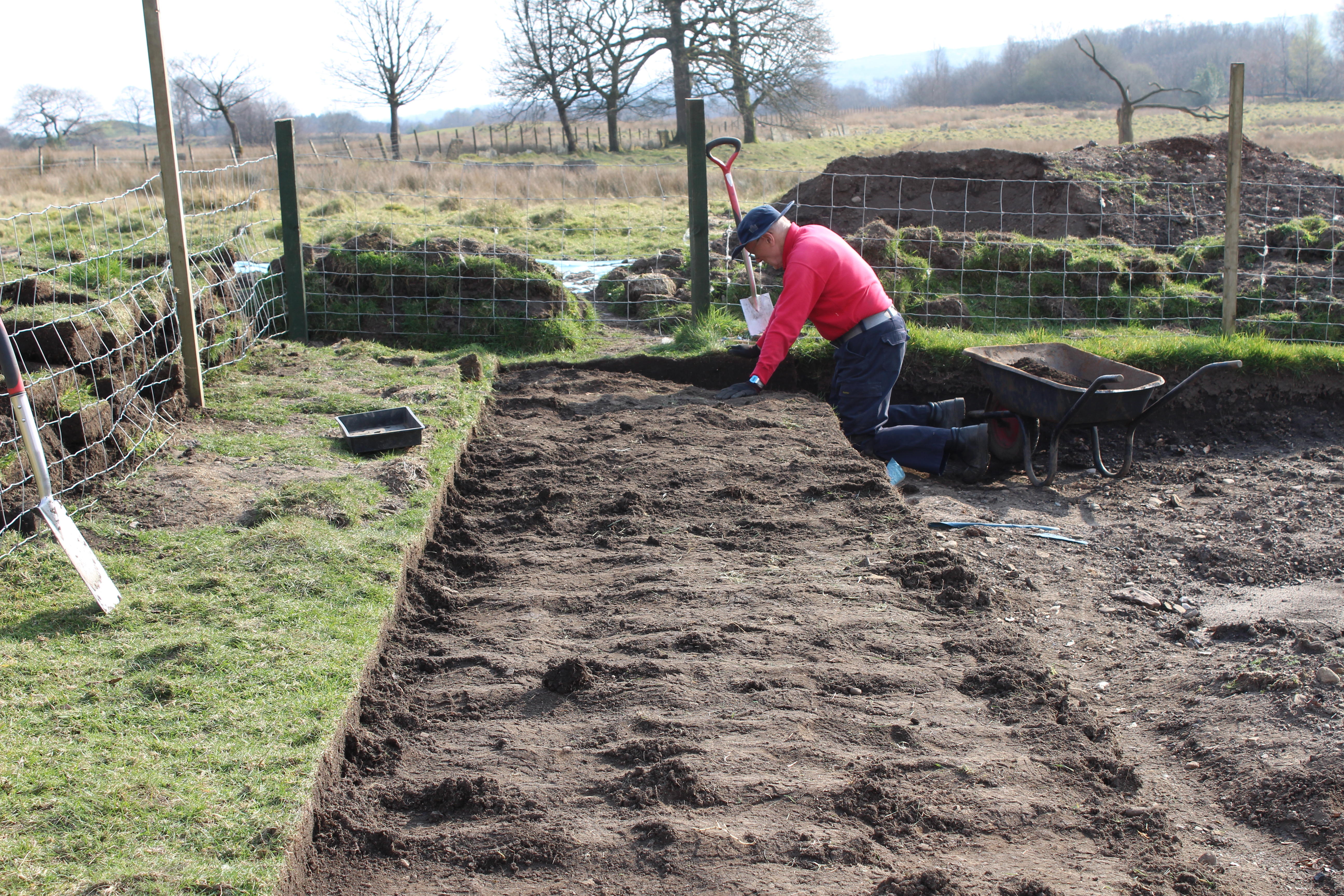
24.3.2
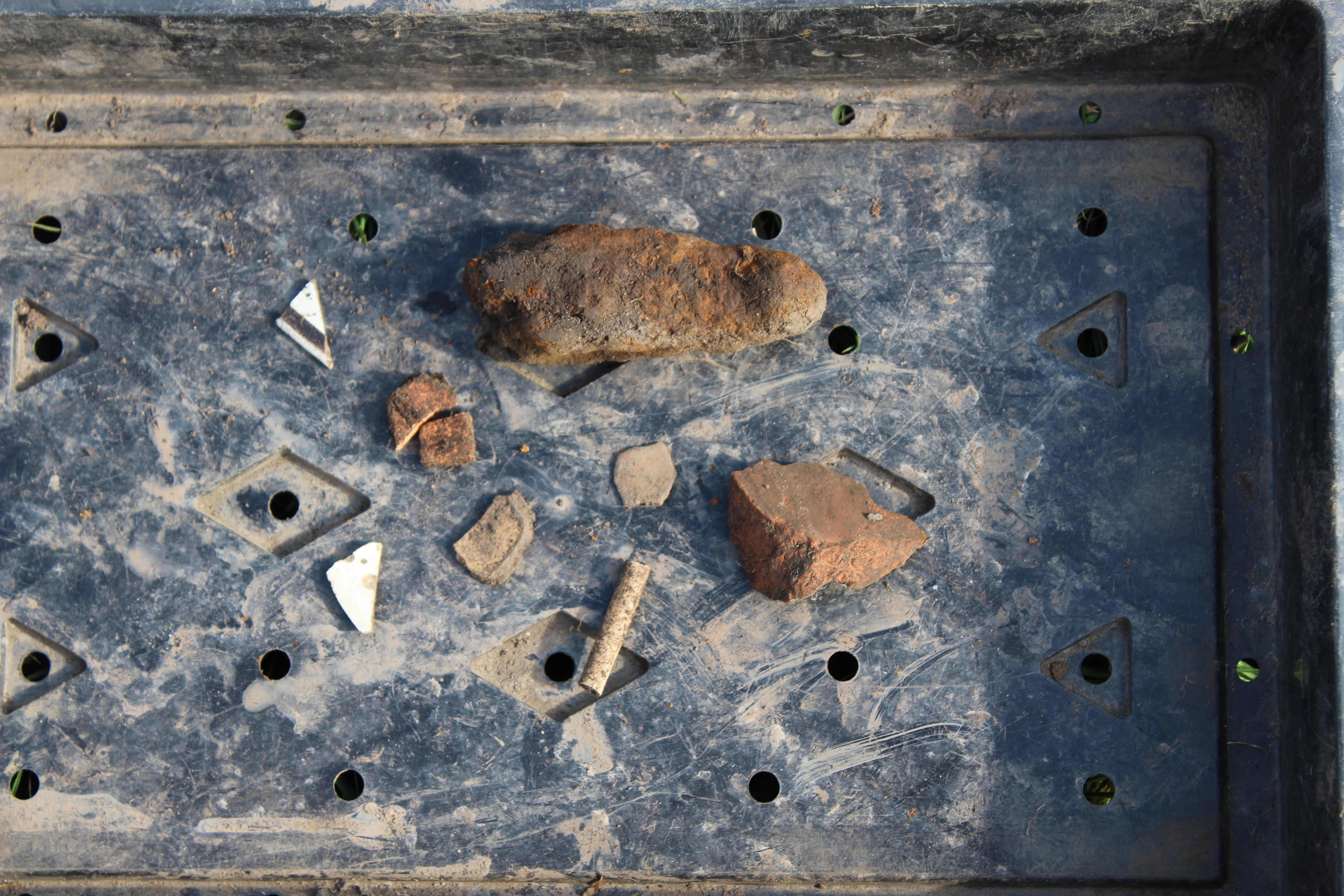
24.3.3
Weekend of the 26th and 27th March
Trench 2 of 2022. This trench is the westerly extension of 2021’s number 1 trench.
On Saturday work continued removing the remainder of the topsoil from this extension. A strip of clay was uncovered on the north face of the trench, running in a south westerly direction, which was identified as the possible extension of a drain discovered in 2018 trenches 4 and 9 to the northeast of this trench. It was thought that this drain may also be part of what was thought to be a drain discovered in the northwest corner of 2021 trench 9. However, due to apparent misalignment there is some uncertainty over this assumption. On Sunday work continued removing the topsoil from the clay covering the drain. Photo 27.3.1
Trench 1 of 2022. This trench is the easterly extension of 2021’s number 1 trench.
Work continued removing the topsoil down to the first context of interest. A tedious task as there were not many finds in the topsoil to heighten interest and the boundary between the topsoil and the context of interest was not well defined, care was therefore necessary to ensure unnecessary damage was not caused to the context layer. Photos 27.3.2 and Photo 27.3.3
Trench 1 of 2021
Work progressed removing the winter protective backfill from the furnace and the large pit uncovered last year. As the furnace was covered with a tarpaulin and earth the structure remained fairly damp which prevented the walls from drying out and it looks to be in a fairly good state of preservation. The pit had been filled with sandbags and covered with a tarpaulin. The sandbags will have to be removed at some stage, but it is assumed the pit will be in a good state as well. Photo 27.3.4
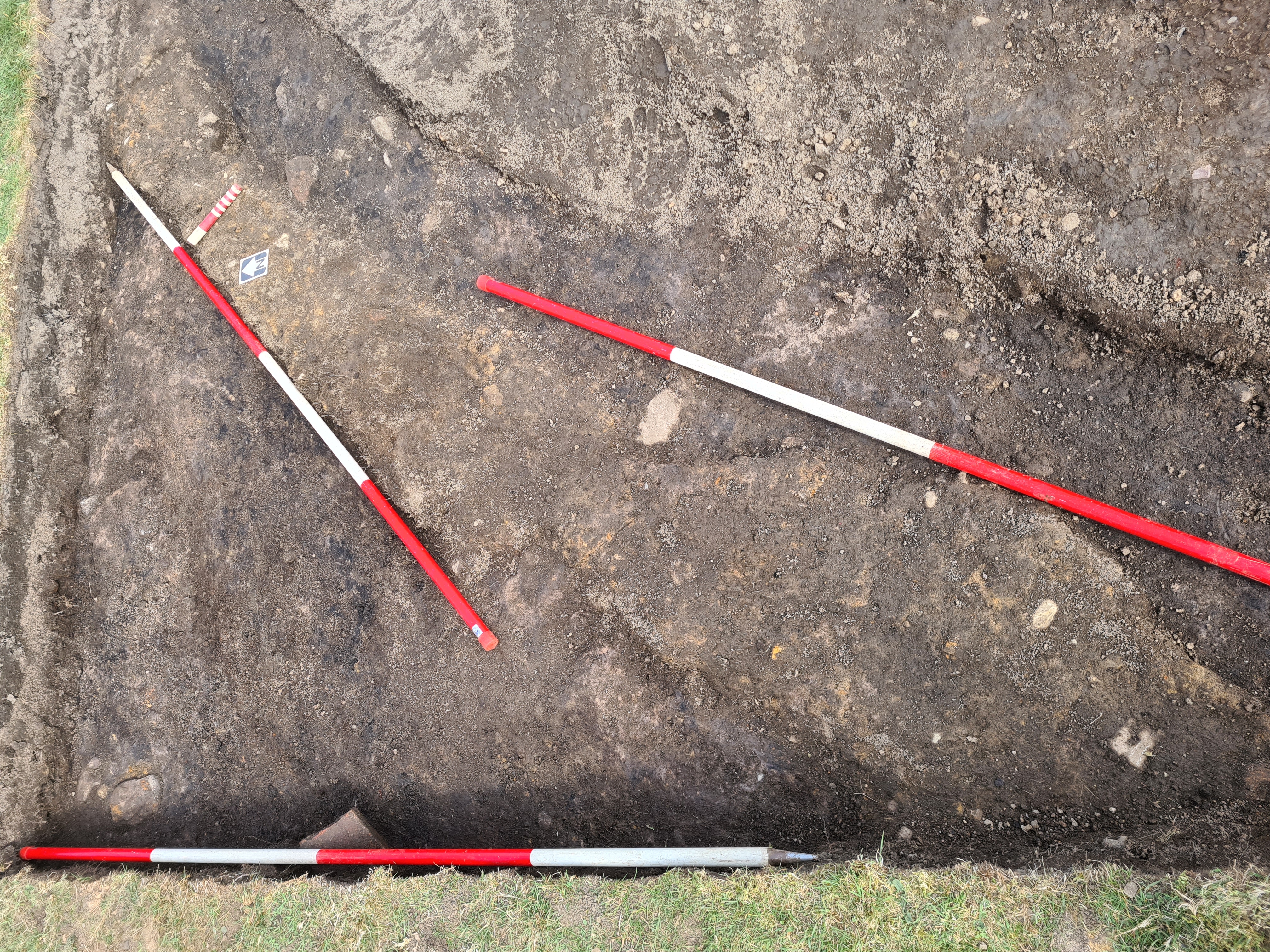
27.3.1
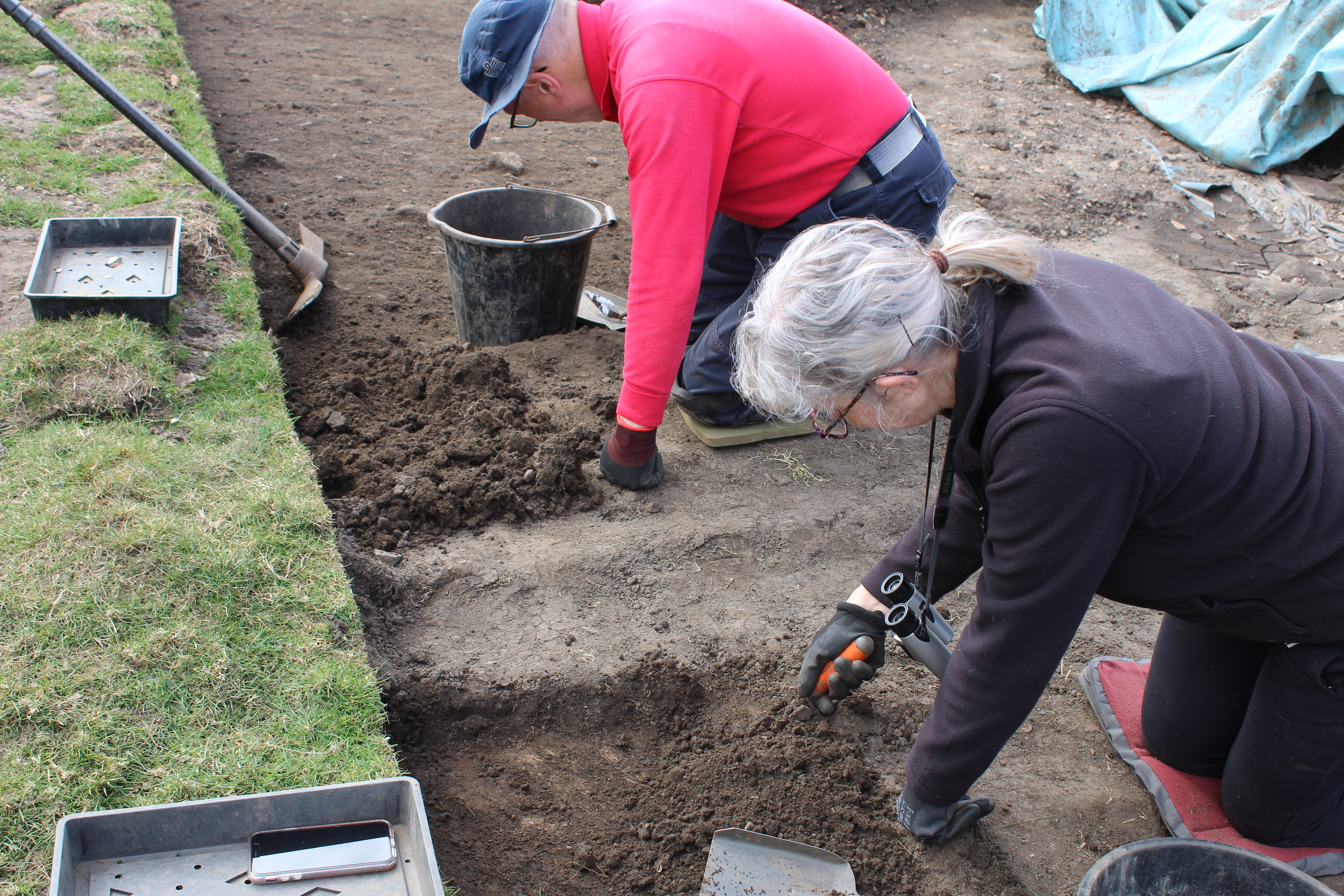
27.3.2
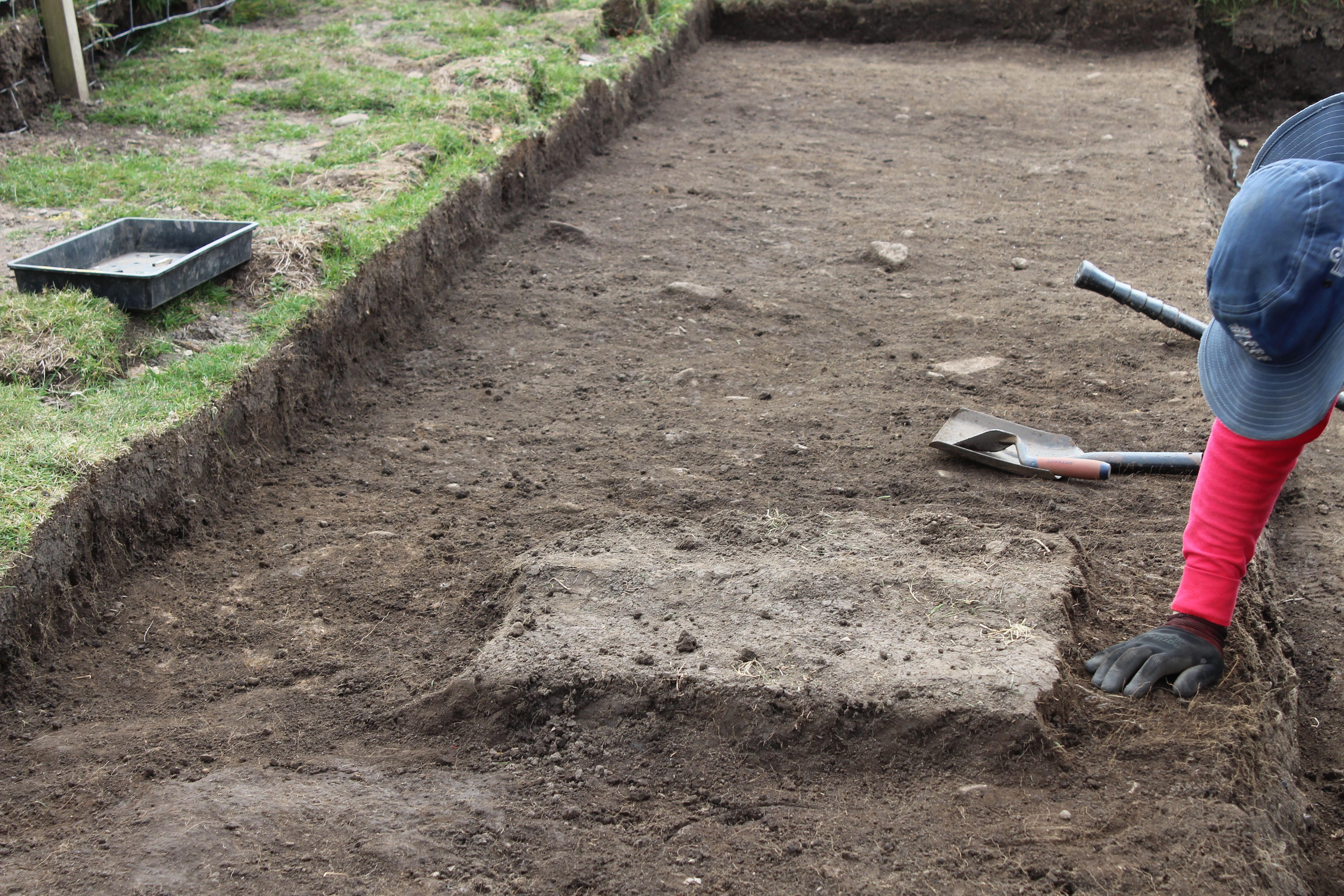
27.3.3

27.3.4
Trench 1 of 2022
During the dig on Sunday 27th March a section of red grit staining was uncovered on the north end of the trench under the slag layer. This staining is usually associated with heavy heating. In order to investigate this staining further topsoil and slag was removed. More patches of red were uncovered at the same level as that discovered on Sunday. The red staining uncovered today looks like heavily burnt clay and not the grit type substance uncovered on Sunday. From experience on the site the burnt clay is usually found in close proximity to a bloomery, predominantly in the upper section of the tapping channel where the intense heat has ‘cooked’ the clay. Unfortunately, it is very difficult, at this stage, to ascertain whether we are close to uncovering another bloomery. Photo 31.3.1. Photo 31.3.2 is of a cross section of the trench showing the topsoil and the thick slag layer which is sitting on top of the burnt clay.
Trench 2 of 2022
Work continued removing the topsoil from the small section of the trench which runs north to south. In the northern part of this section there is a slag deposit which is running up from the north-western section of last year’s trench 1 and the southern section of this years trench 2. The ground to the north of the slag tongue is a mixture of soil, stones, slag and fine black ash deposits. A very complicated context which is very difficult to photograph as the colours blend into each other. Photo 31.3.3. Sometimes it is easier to ‘feel’ the changing surface textures through the trowel rather than see them.
Unfortunately, weather conditions prevailing at the time made working on the site very uncomfortable, so we called it a day at 12:30 hrs.
The next scheduled dig is on Thursday 21st April 2022.
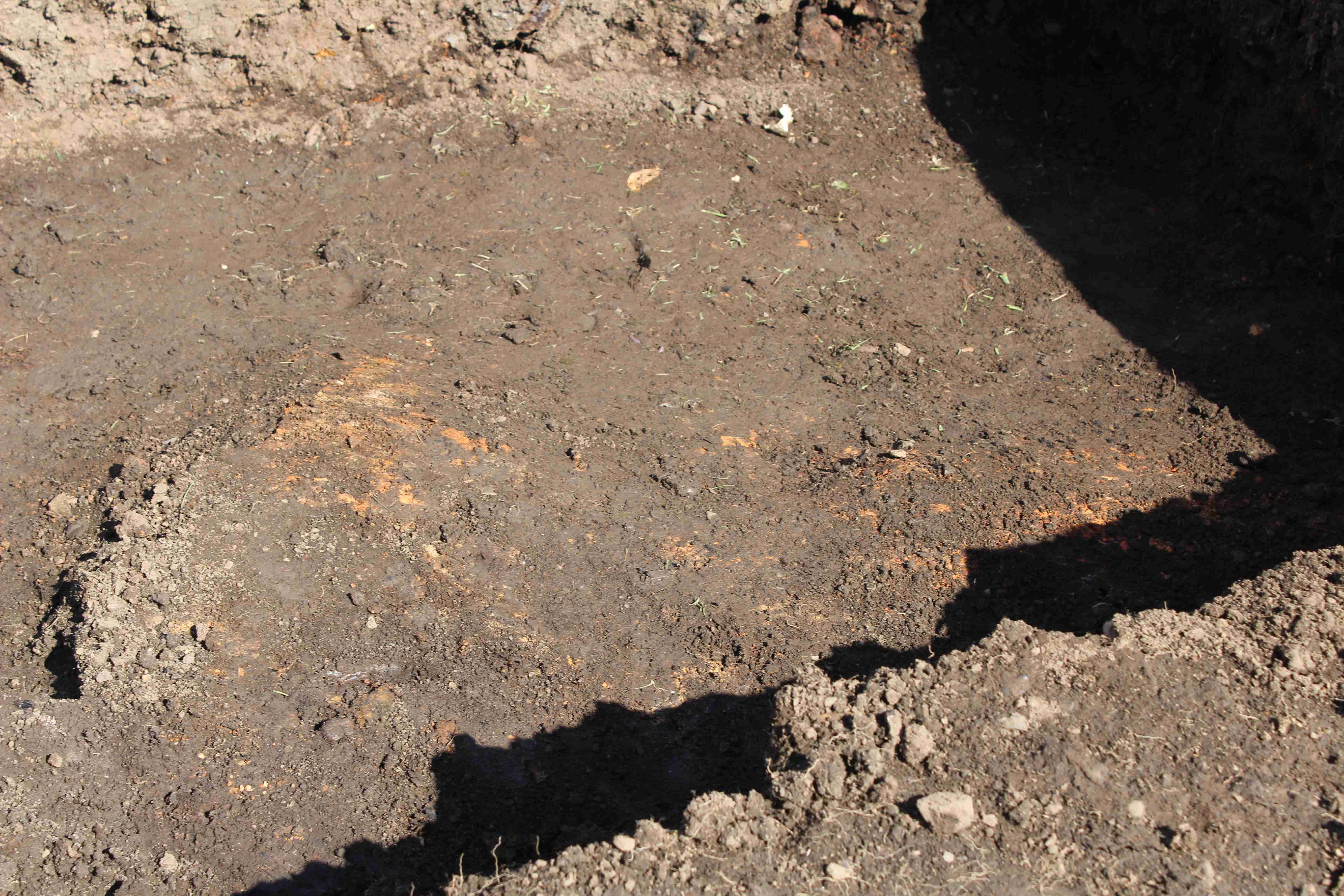
31.3.1
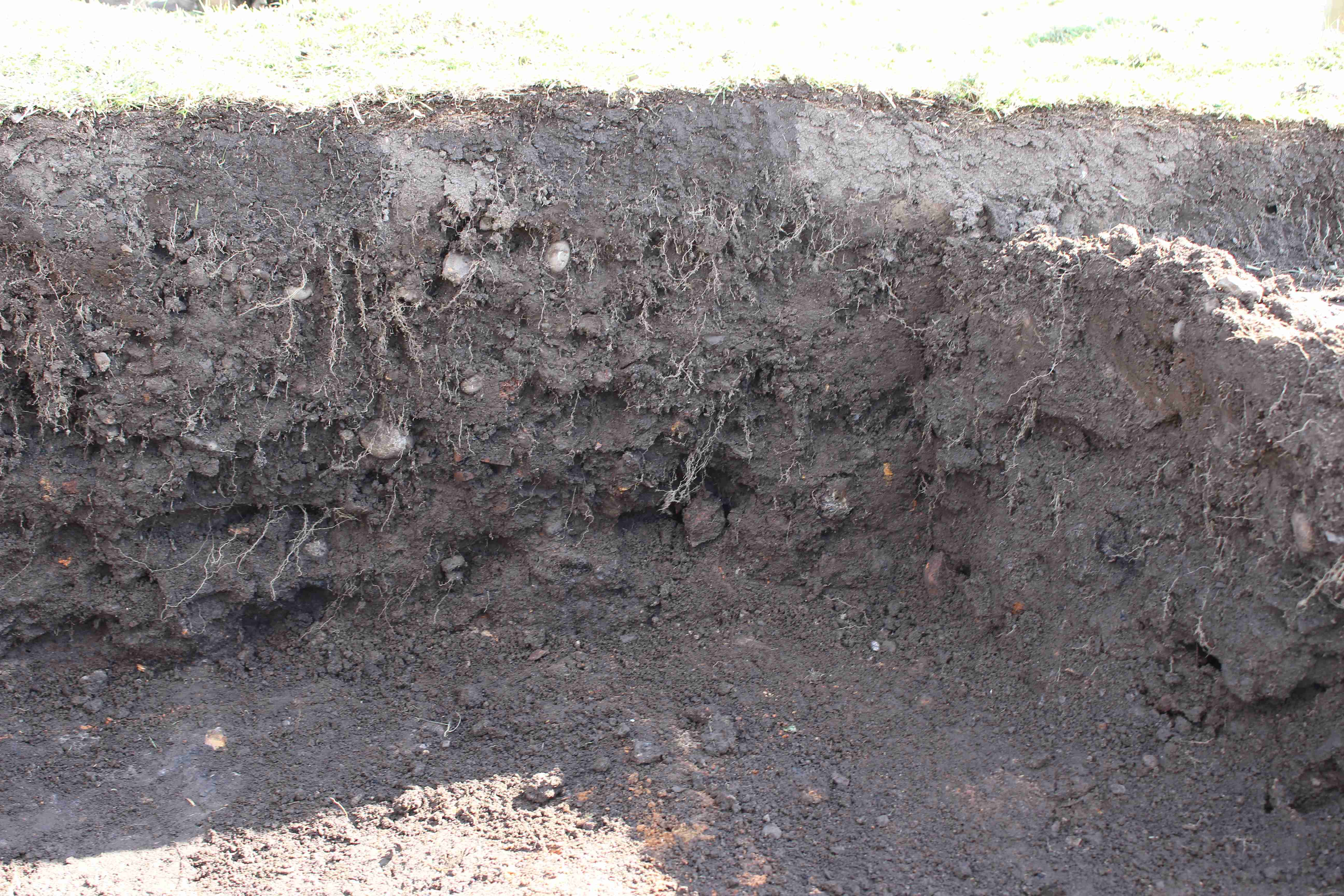
31.3.2
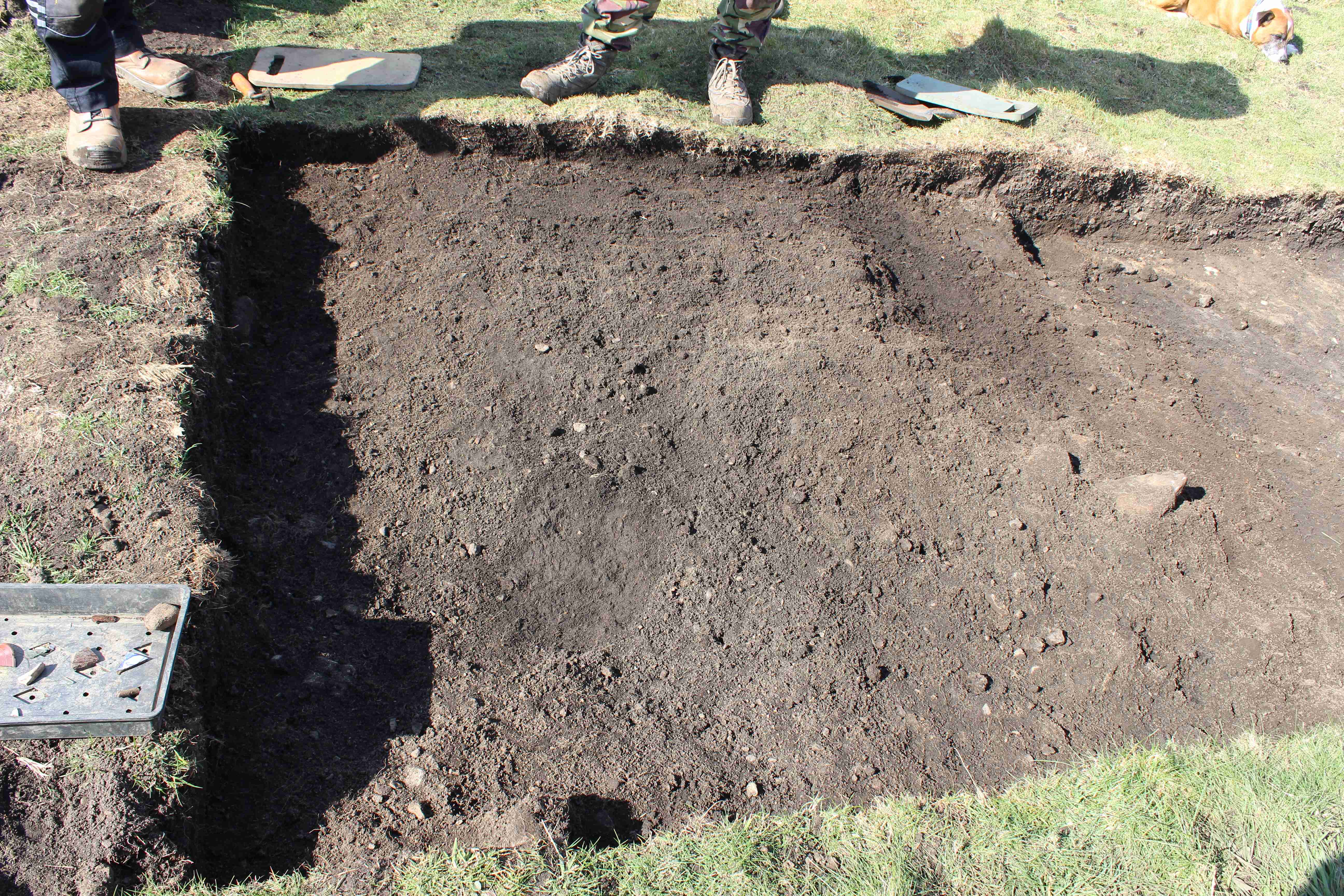
31.3.3
2021 Trench 1
Work continued removing the protective backfill laid down at the end of the 2021 dig, concentrating on exposing the top of the northwest portion of the trench which exists around the furnace. Work also commenced removing the sandbags and coverings of the furnace. At the moment, it looks as if the protective backfill of the trench and furnace has been successful as the archaeology looks to be in good condition. Hopefully the areas still to be uncovered are in a similar condition. Photos 21.4.1 & 21.4.2
2022 Trench 1
This is the new section adjoining the east face of the 2021 trench 1. Work continued on the northern sector of the trench removing the remaining topsoil. During the process a couple of pieces of late pottery were recovered. The topsoil in this section of the trench has a large amount of slag in it, which is expected to run out as the trench progresses towards the south. Currently, there is a bulk of soil some metre and a half thick between this section and the next section which is clear of slag. Somewhere in the bulk of earth the slag layer finishes. There is a suspicion that a trench may exist running east to west to join up with the trench going around the furnace. This may be where the slag stops. It will be very interesting to see how this supposition works out. Photos 21.4.3 & 21..4.4
Work also continued removing the topsoil on the section of the trench just beyond the bulk of earth. The soil here is clear of slag and easy to excavate. At the end of the day a number of heavily burnt flat stones were unearthed and, from the looks of things, will continue to run in a southerly direction. Obviously, at the moment, it is not possible to ascertain the extent of these stones. We do however have high hopes that these stones are going to reveal some very interesting archaeology. Saturday's dig should be very interesting. Photos 21.4.5 & 21.4.6
2022 Trench 2
This trench lies on the west face of the 2021 trench 1.
As with the other trenches work continues removing the topsoil. Previous digs uncovered the top of the anticipated drain running southwest to northeast. To the east of this drain are a couple of large deposits of clay. It is uncertain whether these clay deposits cover archaeology or were just surplus to requirements. The deposits will have to be recorded before they can be removed to ascertain if anything lies beneath. At the end of last year’s dig there was a hint that archaeology extended beyond the west face of the 2021 trench in the direction of these clay deposits, but at a lower level. Will there be anything worthwhile to find under there? Let’s hope so. Photos 21.4.7 & 21.4.8
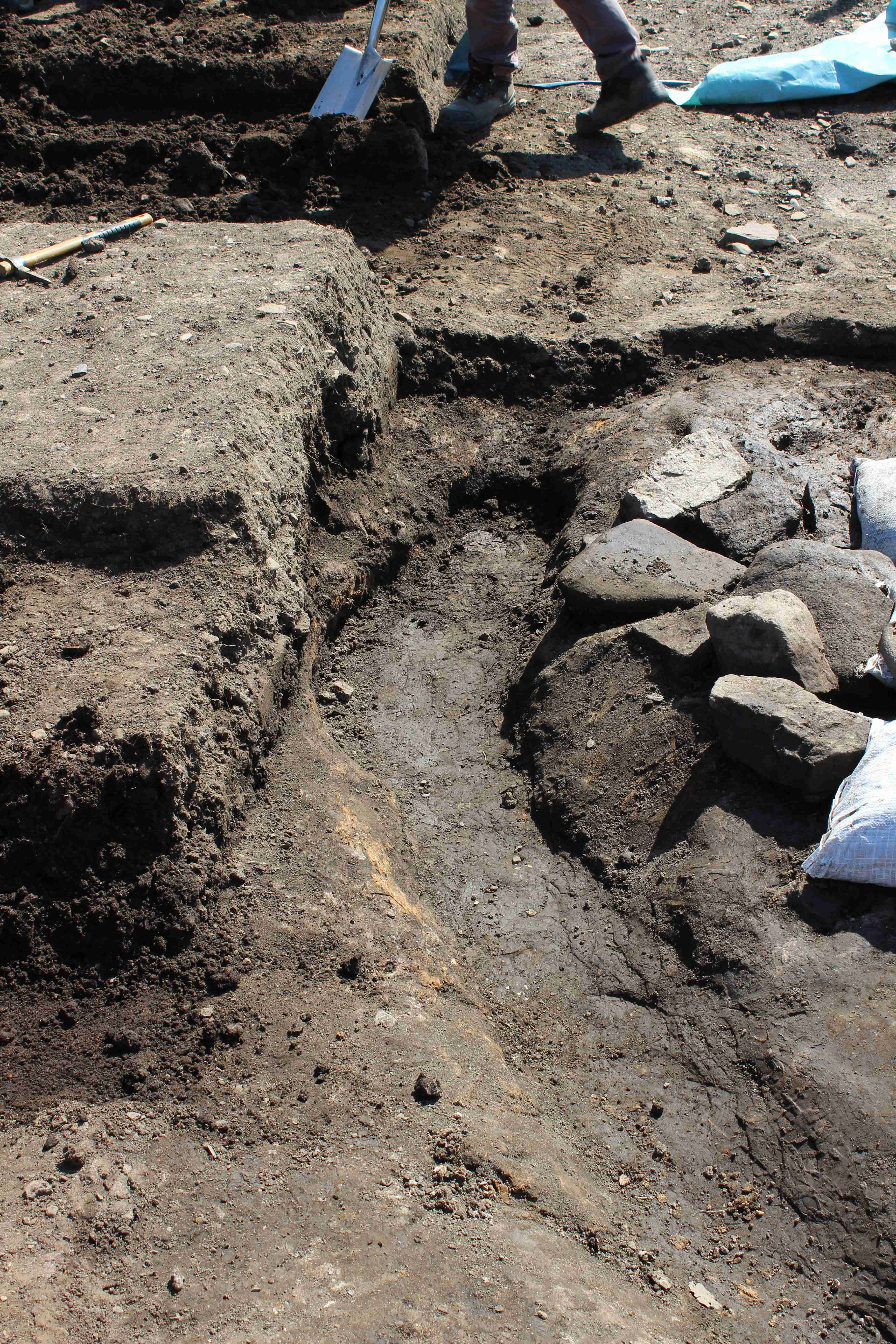
21.4.1
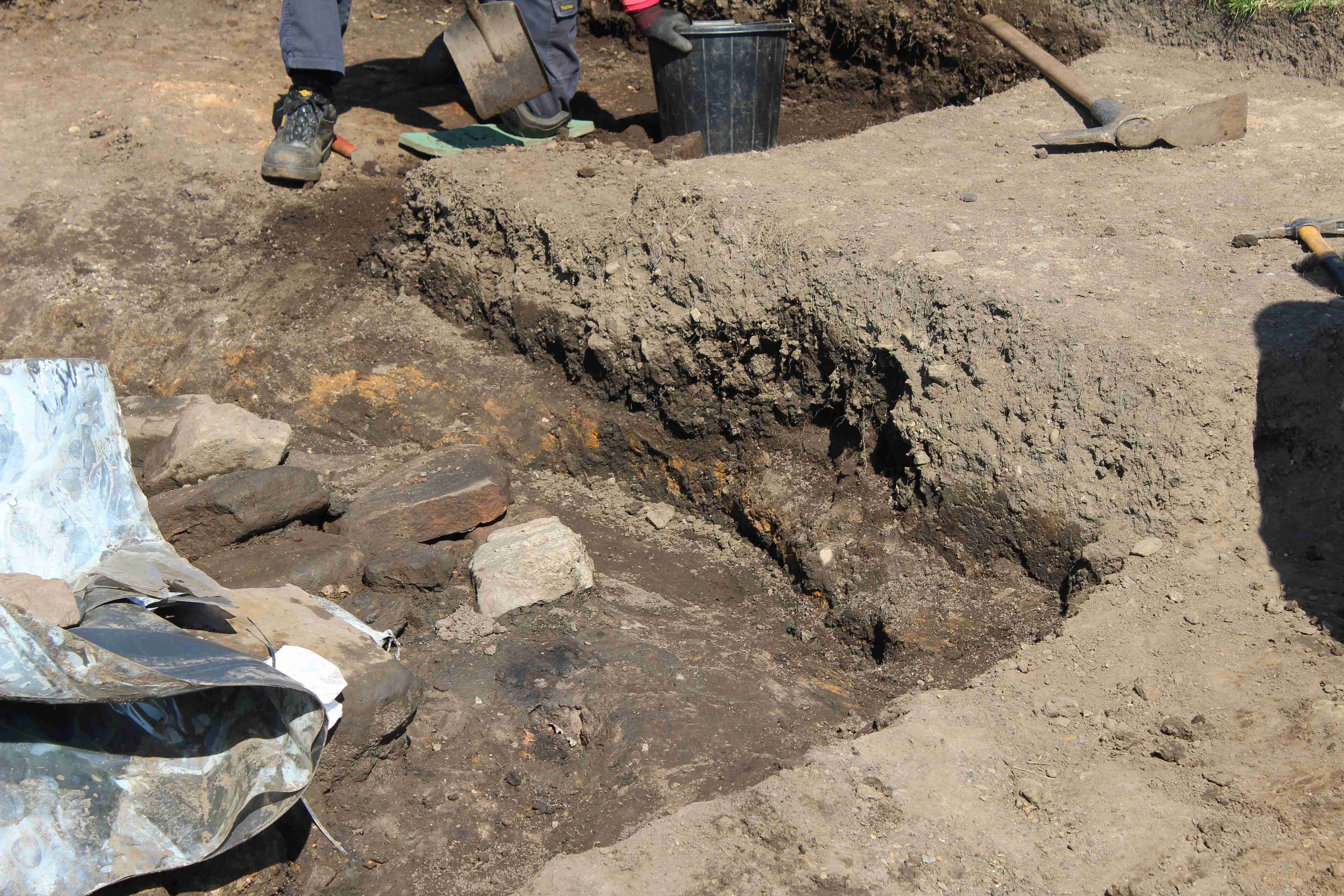
21.4.2
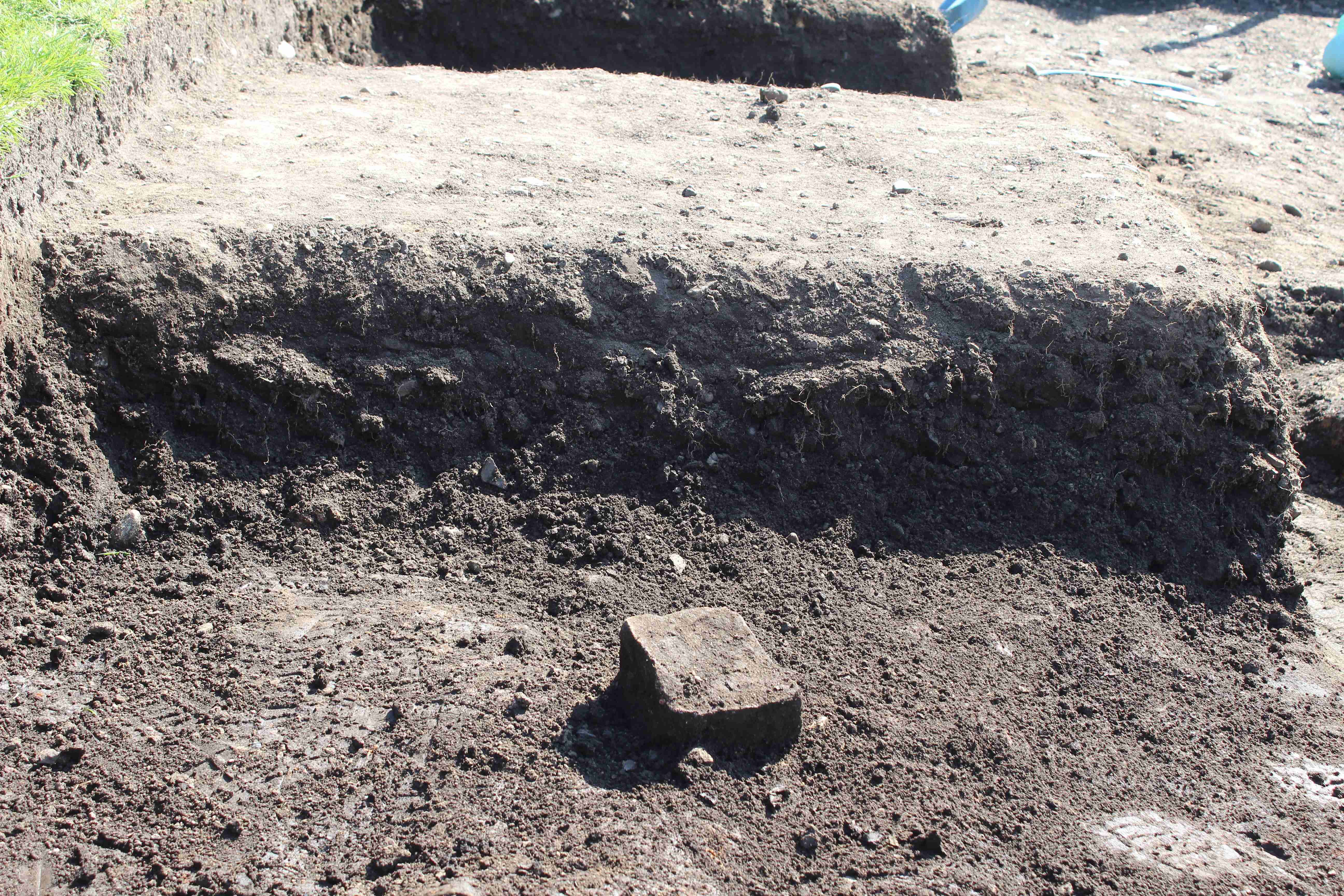
21.4.3
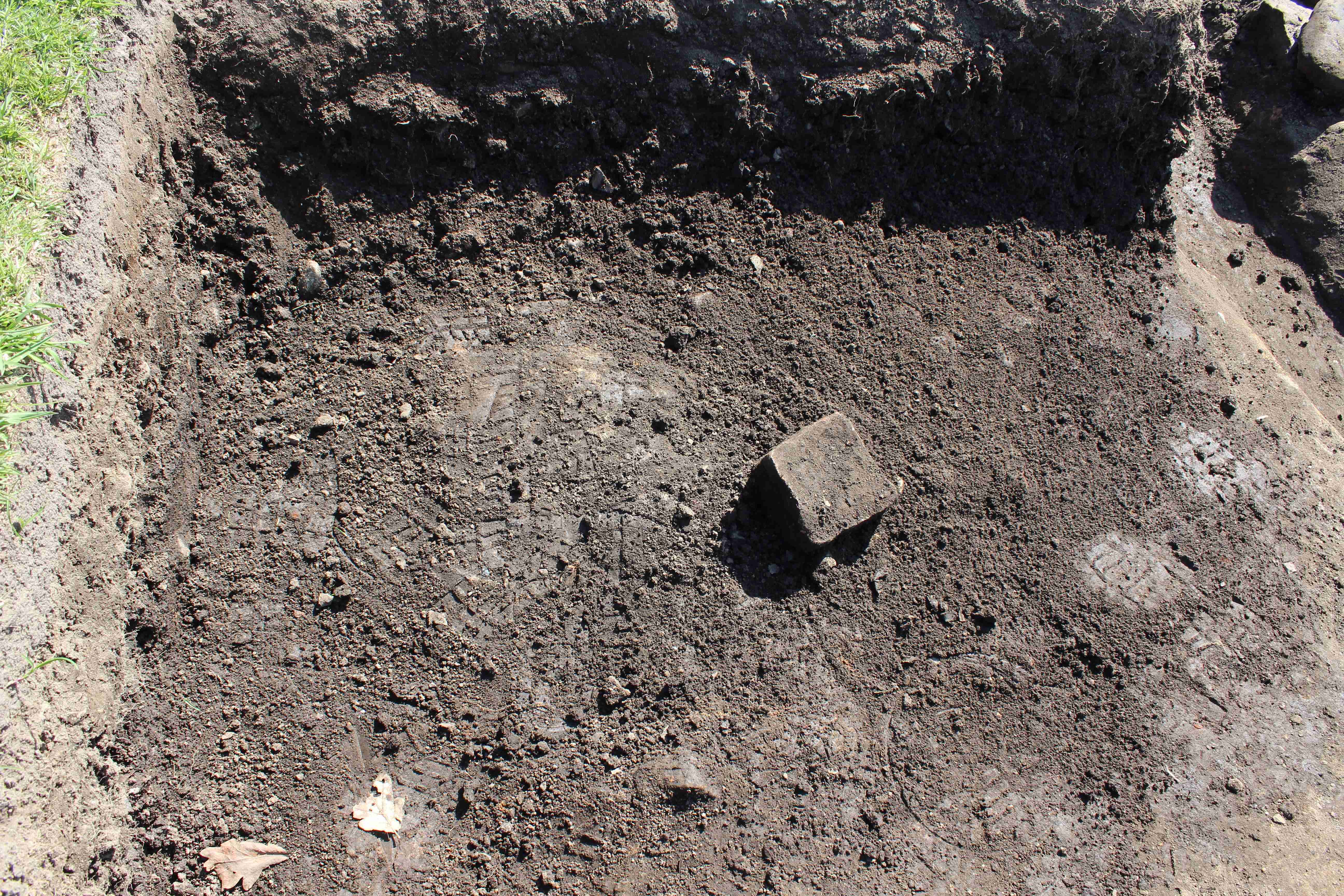
21.4.4
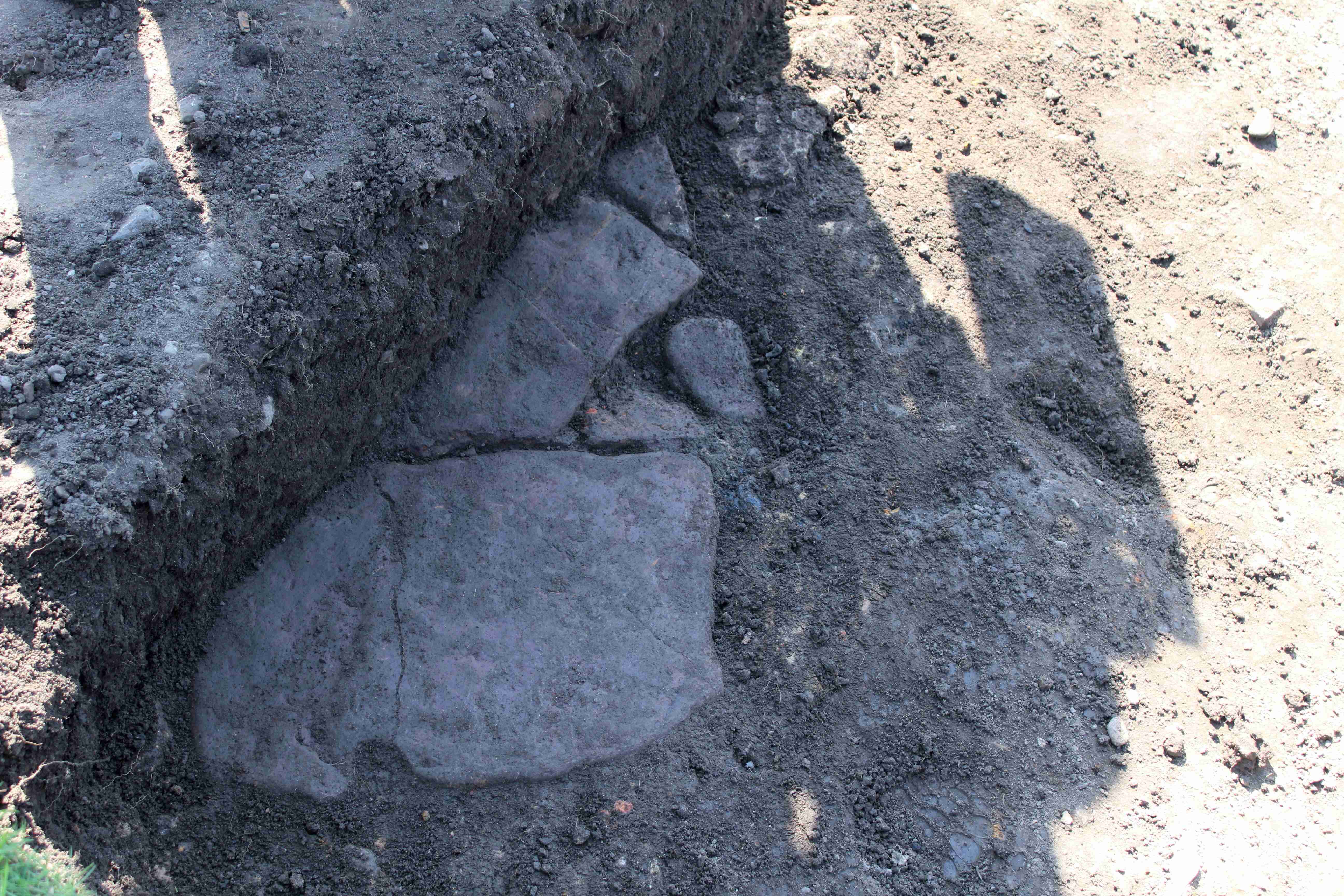
21.4.5
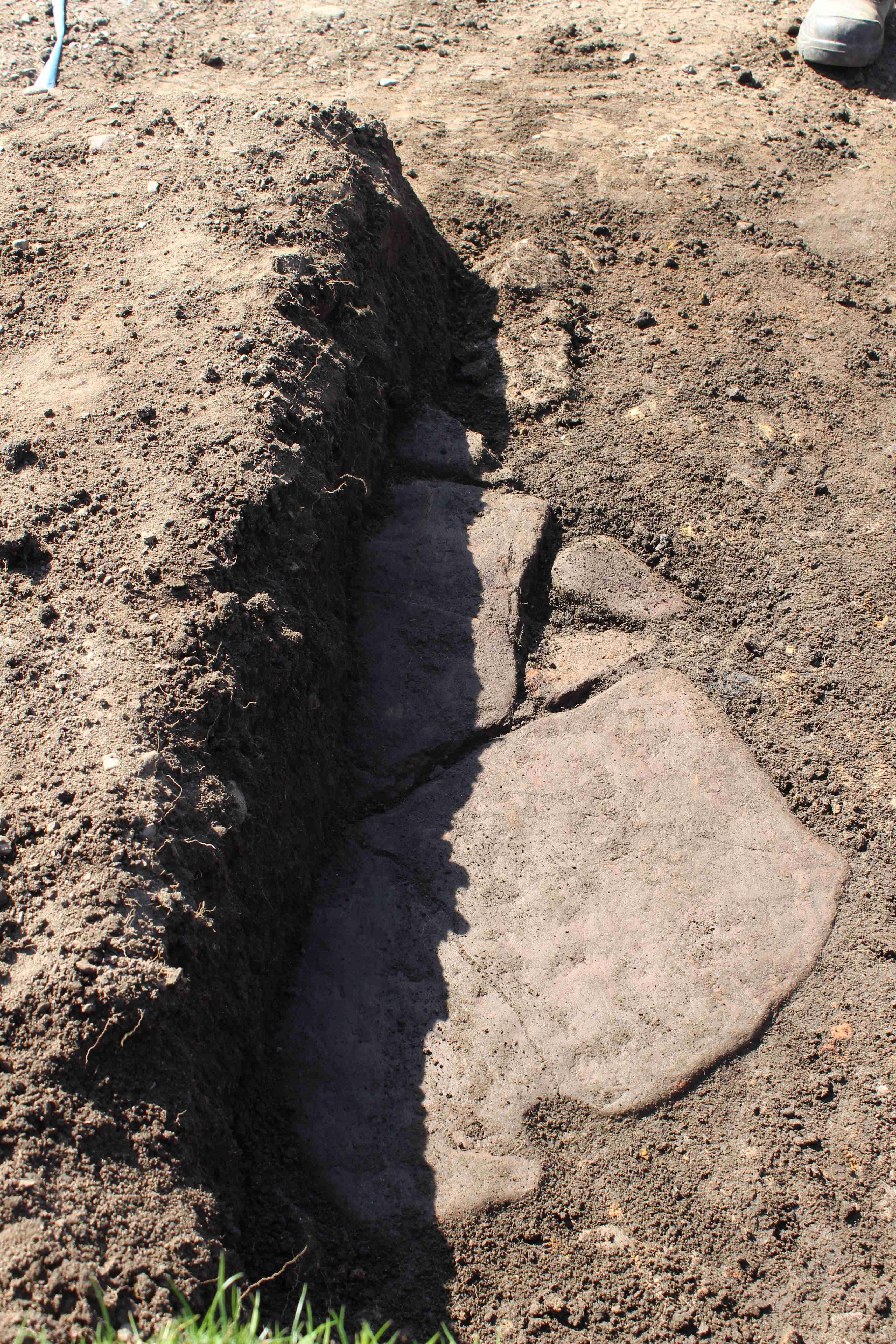
21.4.6
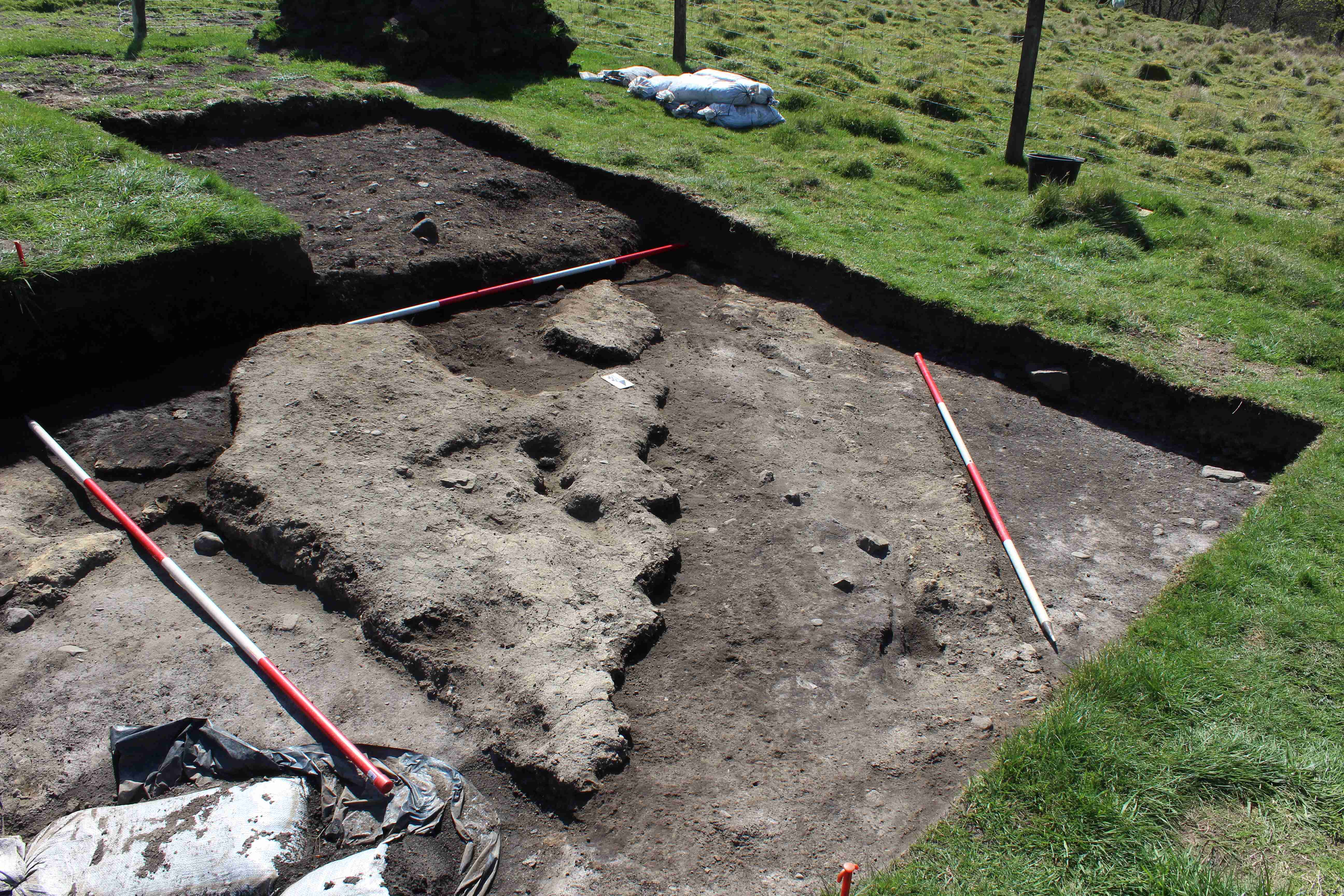
21.4.7
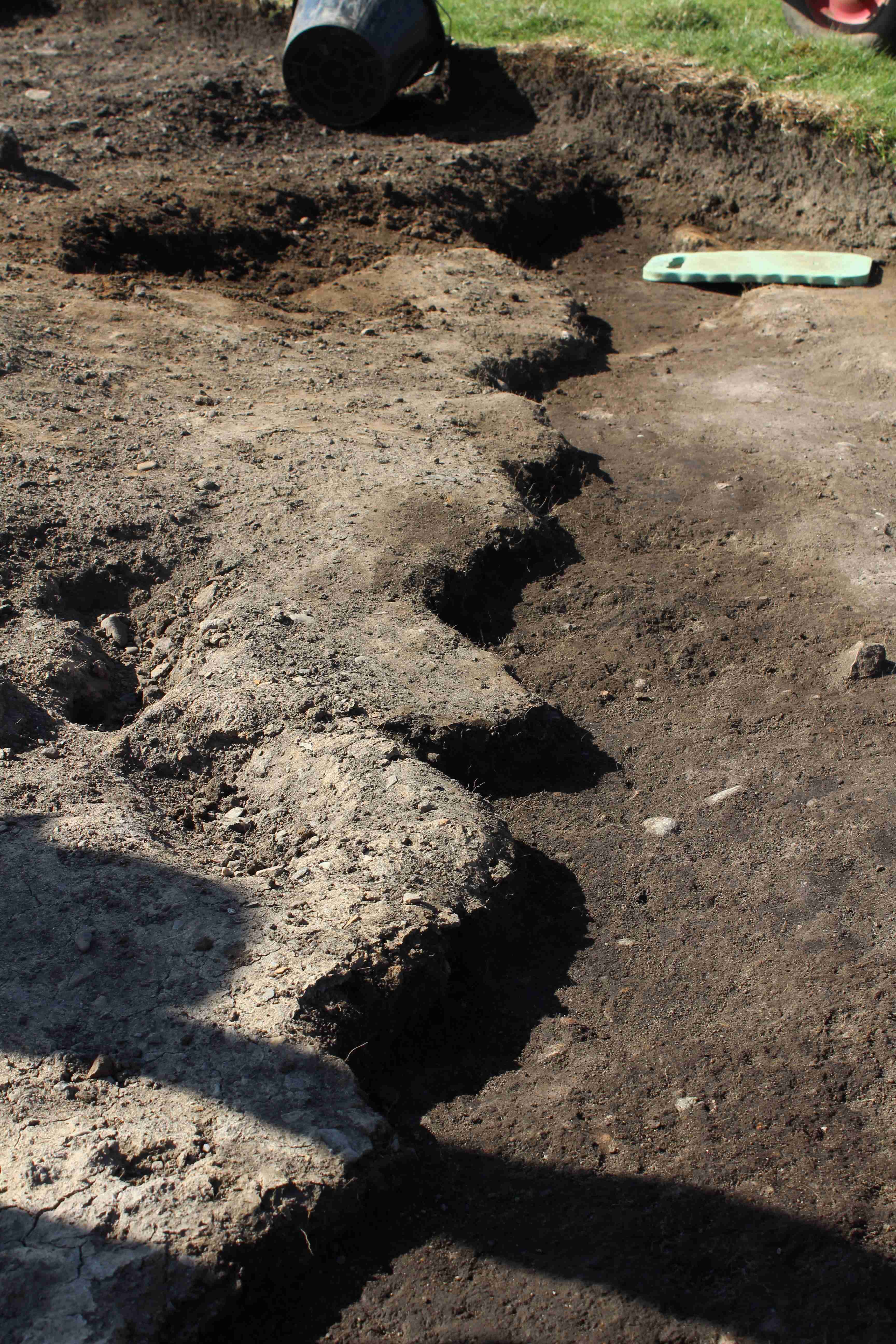
21.4.8
2022 Trench 1
From report for Thursday 21st April.
There is a suspicion that a trench may exist running east to west to join up with the trench going around the furnace. This may be where the slag stops. It will be very interesting to see how this supposition works out.
Was there a trench under the bulwark of earth? Unfortunately not; the slag just petered out. Photo 24.4. 01
2022 Trench 2
From report for Thursday 21st April.
To the east of this drain are a couple of large deposits of clay. It is uncertain whether these clay deposits cover archaeology or were just surplus to requirements.
Was there anything under the two large clay deposits? Again, unfortunately not, so it looks as if these two clumps of clay were also surplus to requirements and just dumped there. Photo 24.04.02
2021 Trench 1
Work continued recording sections of the bloomery, concentrating on the tapping arch area.
Photo 24.4.03
The preservation sand bags which were placed in the large pit associated with the trench running around the bloomery were removed. Although there was some water in the bottom of the pit, it is in very good condition; no collapsing of the sides had occurred. The intention is to record the pit then backfill it. 24.4.04
2022 Trench 1
The remaining bulks of topsoil were removed over the weekend. Nothing of archaeological interest was found under the topsoil in the vicinity of the bloomery.
Continuing to clear the area of the trench where the flat stones were uncovered revealed a number of other stones, one of which was set vertically into the ground and had a lot of hammer scale on its west face. Hammer scale is caused by the bloom of iron from the bloomery being heated in a string hearth, then struck with a hammer to drive out impurities. At the same time you get small particles of red-hot iron being expelled - the hammer scale. As you can see from photo 24.4.05 the stone holds that much iron the telescopic retrieving magnet tool has no problem sticking to it. Unfortunately, as a large section of the hearth appears to be missing, a full-scale inspection and interpretation of the hearth cannot be made. Photo 24.4.06
2022 trench 2
The drain running across the corner of the northwest portion of the trench was excavated. This exposed the very well-constructed drain which is a continuation of the drain excavated in a nearby trench a couple of years ago. Normally most drains are a box construction; this drain is triangular – a vertical side stone, a bottom stone and a capping stone forming the hypotenuse of the triangle. An unusual construction but effective none the less. In the associated photograph there are additional smaller stones on the sloping sides, there to plug any gaps. Photos 24.4.07 and 24.04.08
2022 trench 3
This is a new trench opened on Sunday, situated between 2021 trenches 4 and 5 where most of the excavated mediaeval pottery sherds have been recovered. Hopefully there will be more similar finds in the trench. During the removal of the lower portion of topsoil two small sherds of the mediaeval Holcombe Gritty Ware were unearthed. Photos 24.4.09 and 24.04.10
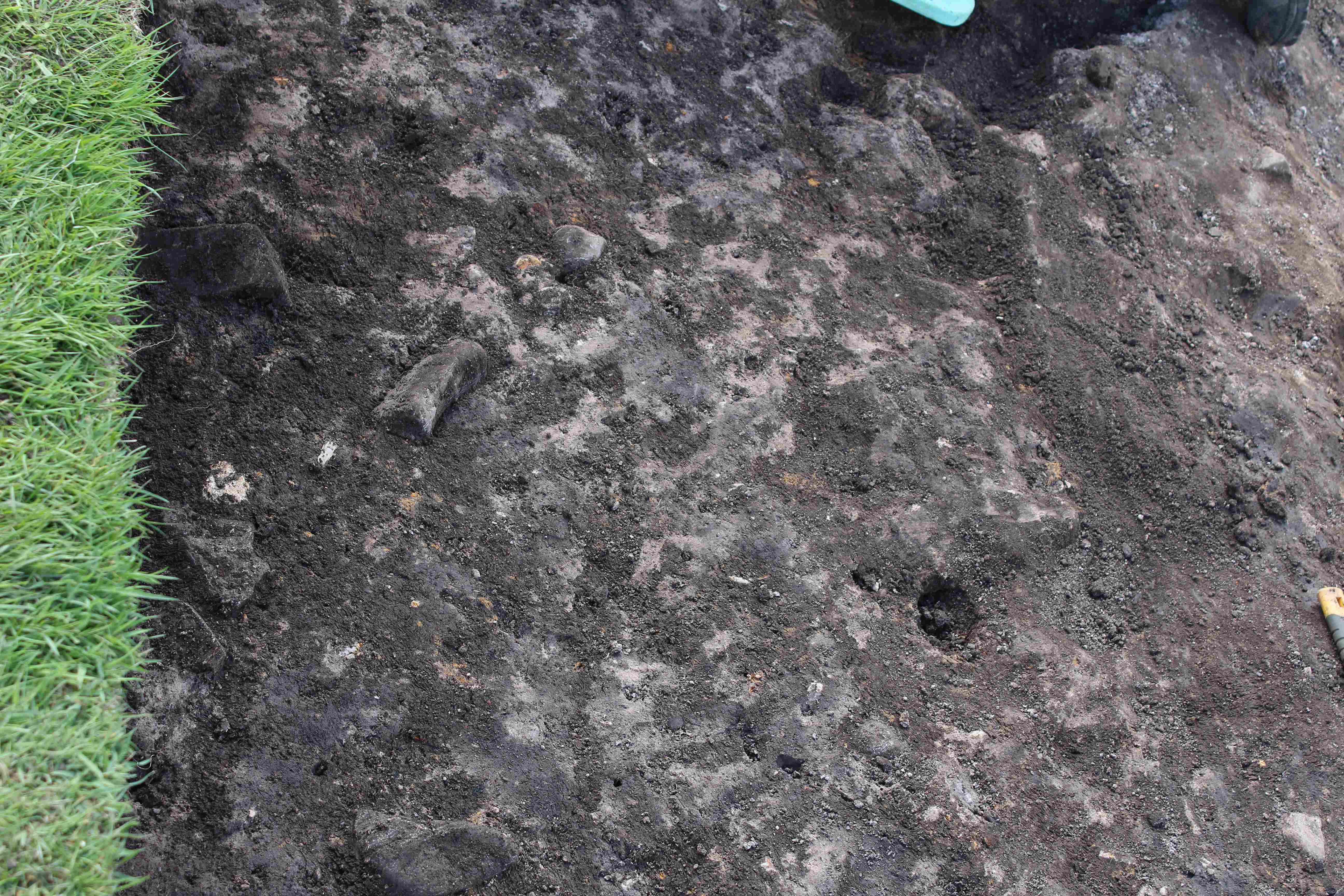
24.4.1
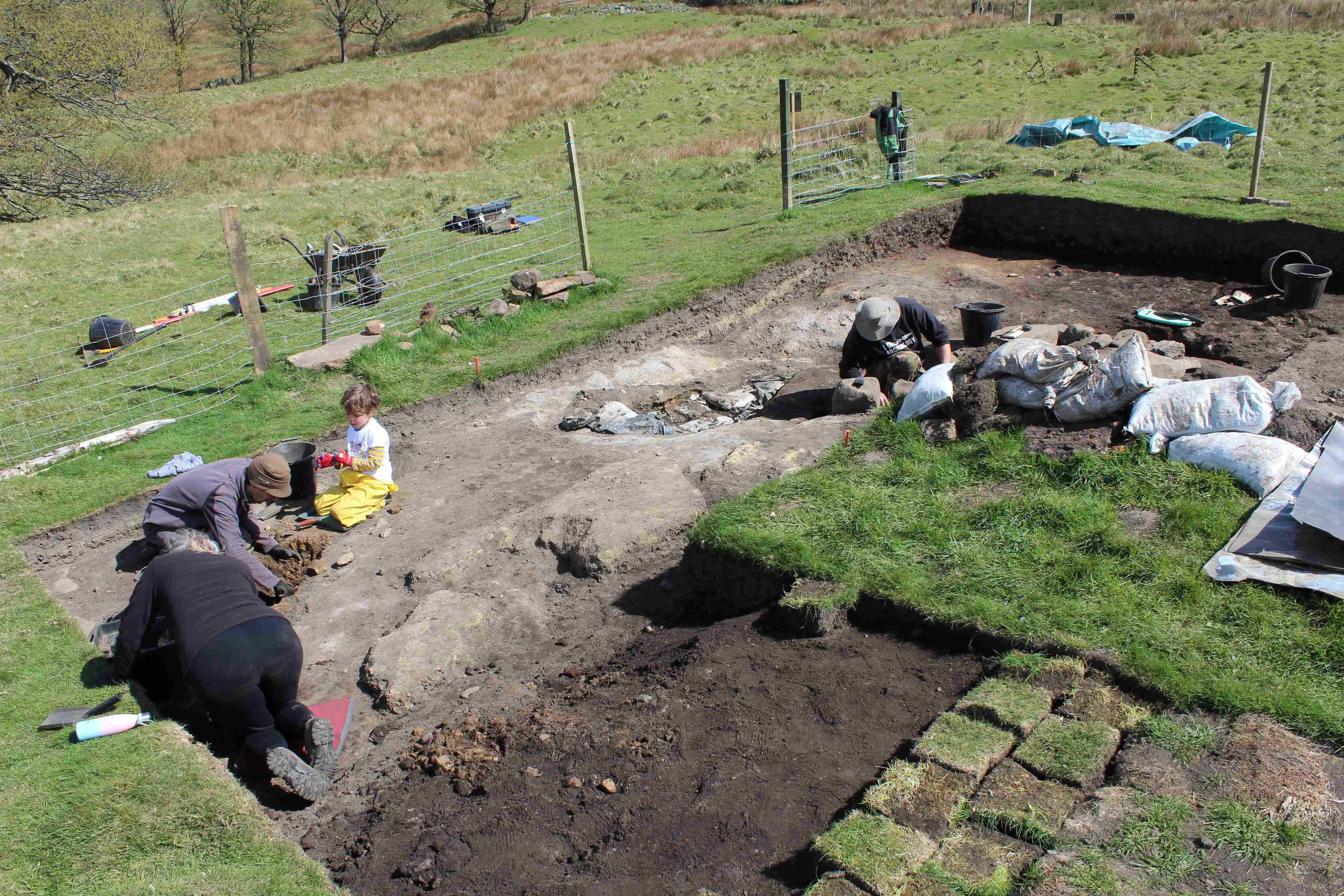
24.4.2
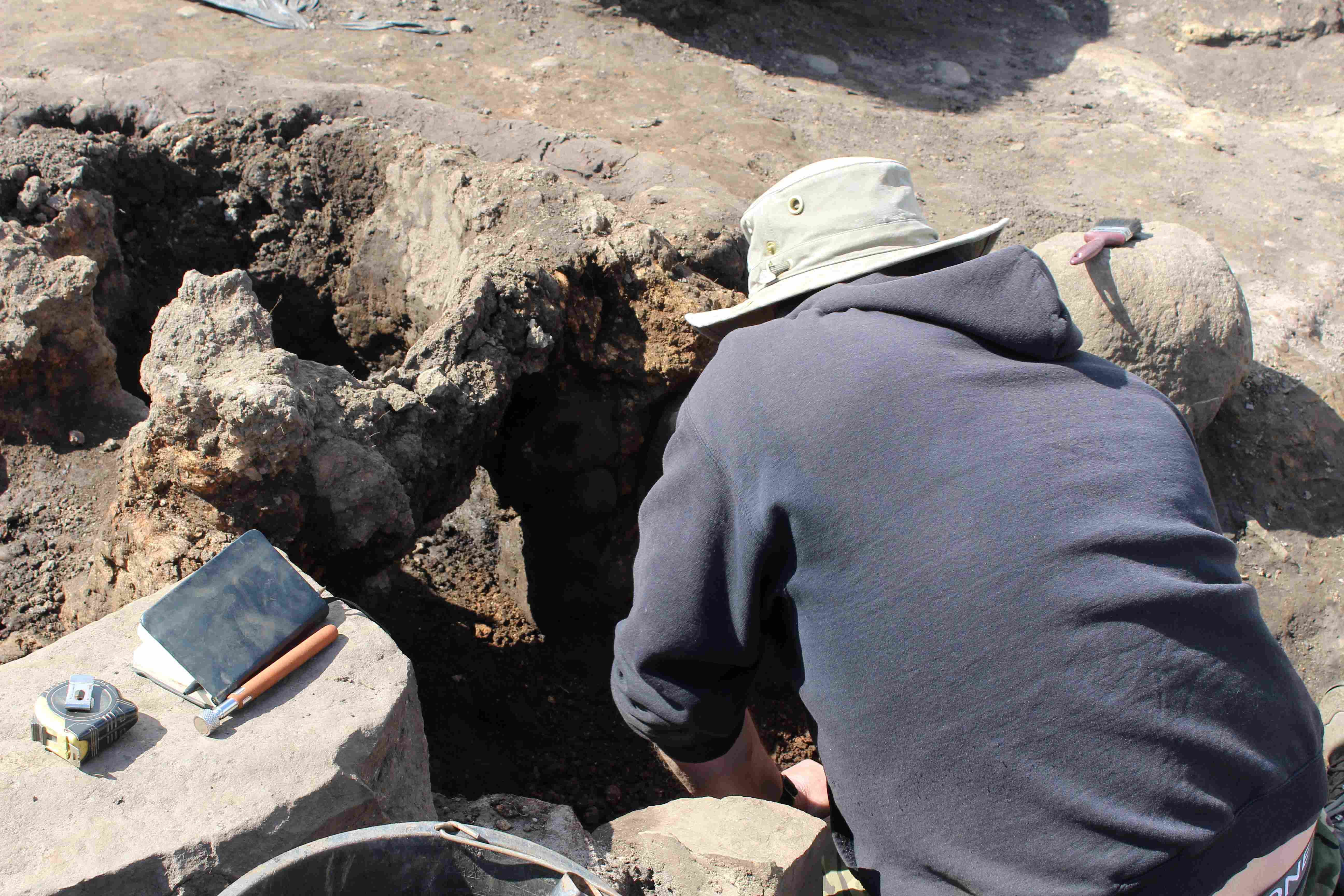
24.4.3
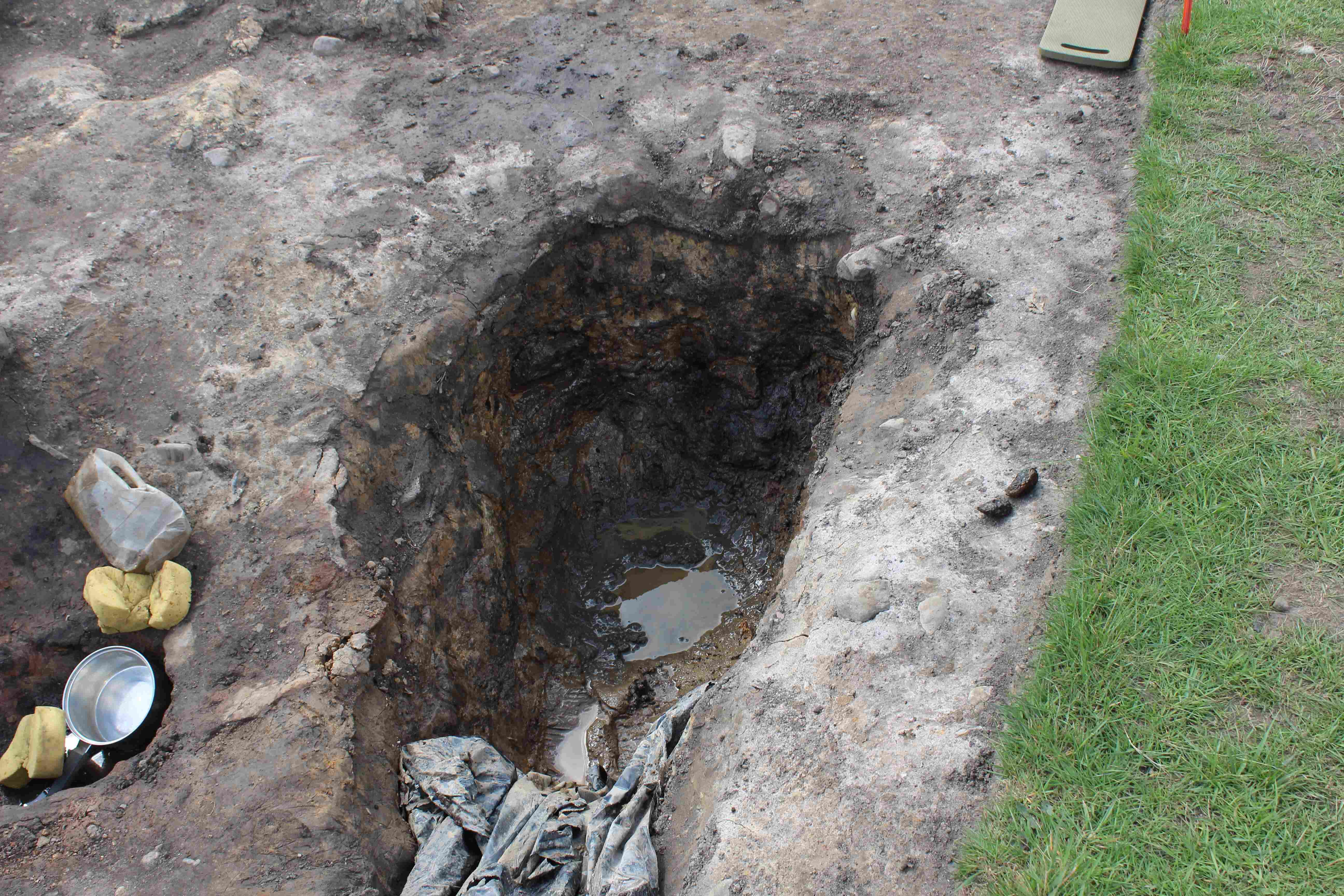
24.4.4
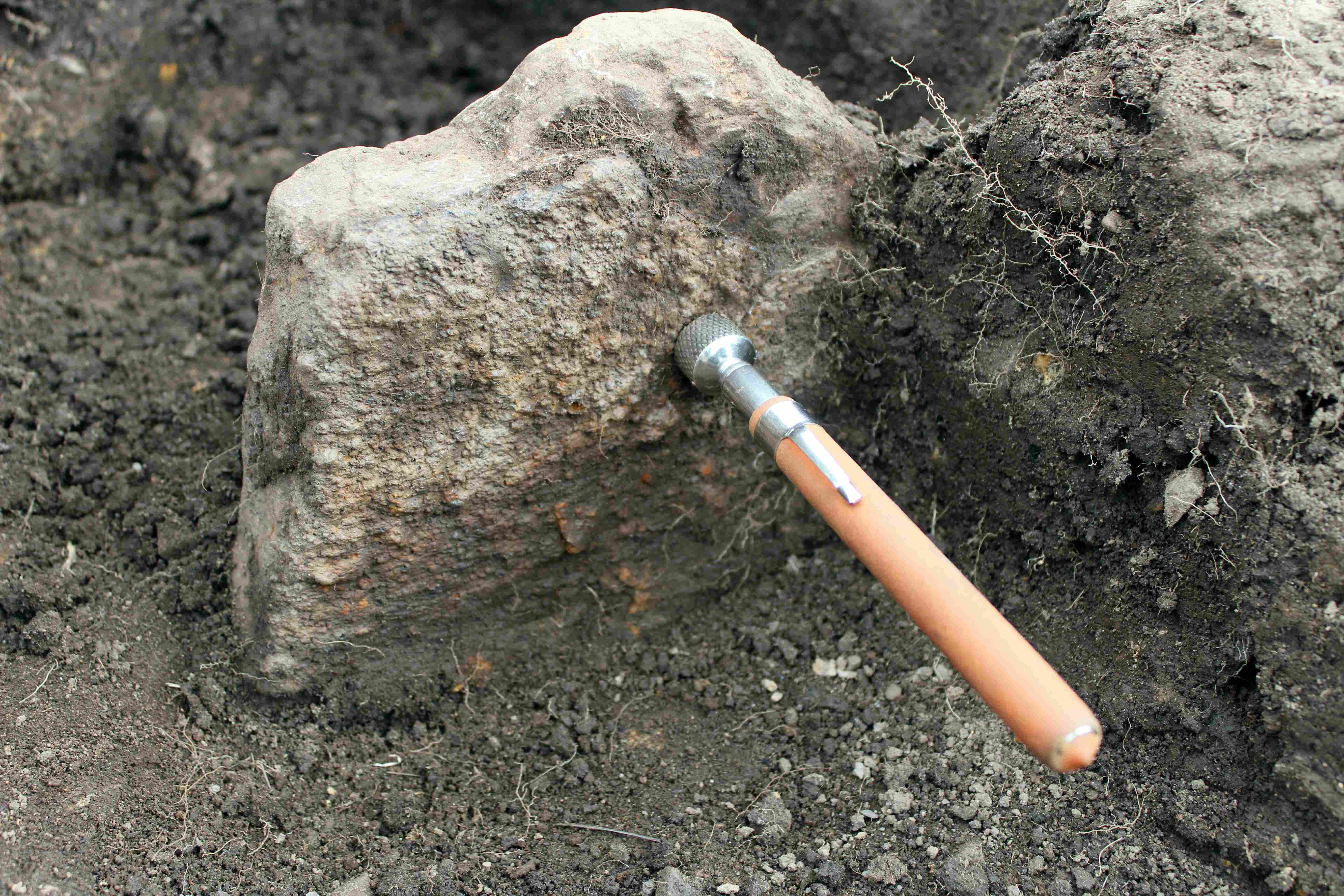
24.4.5
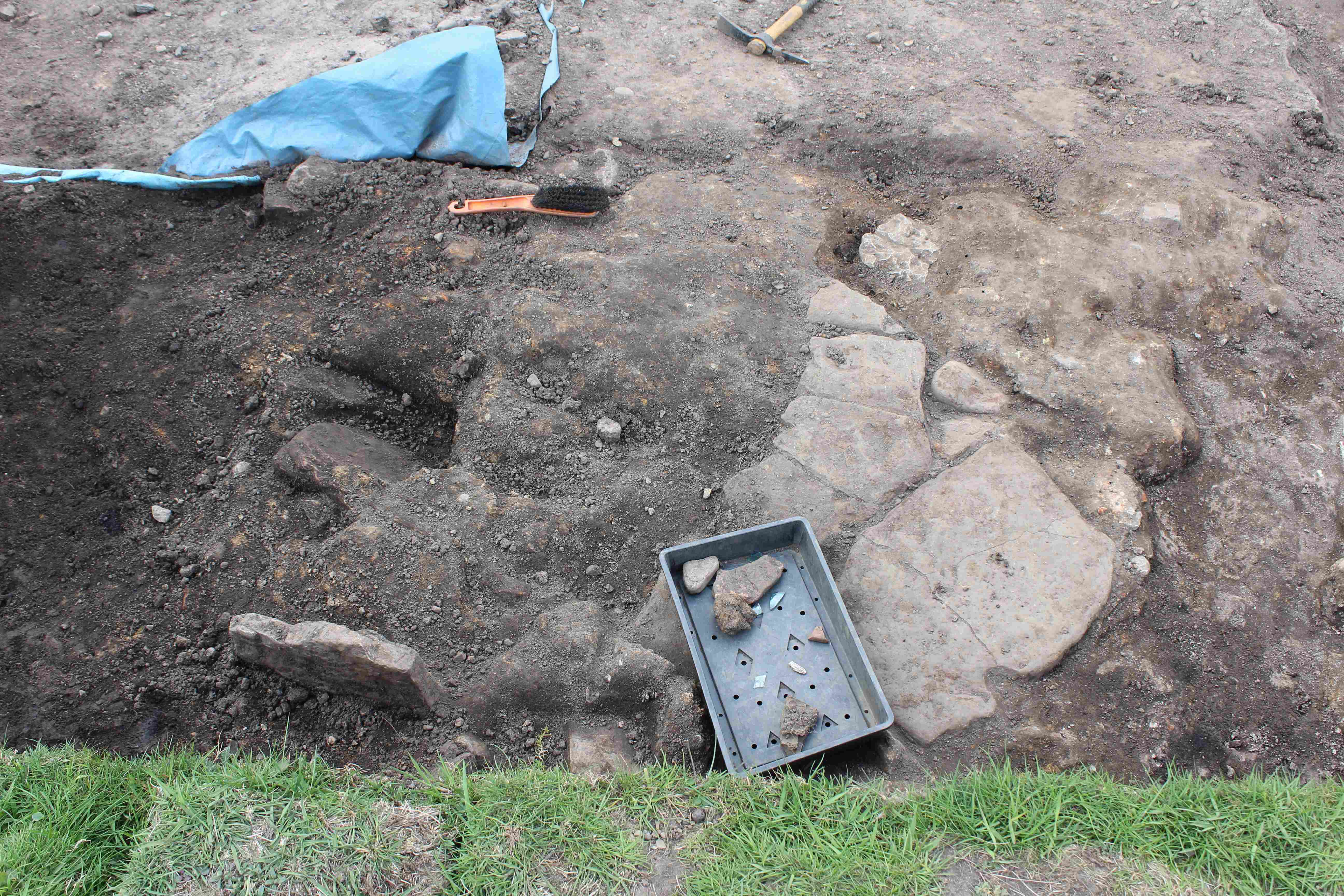
24.4.6
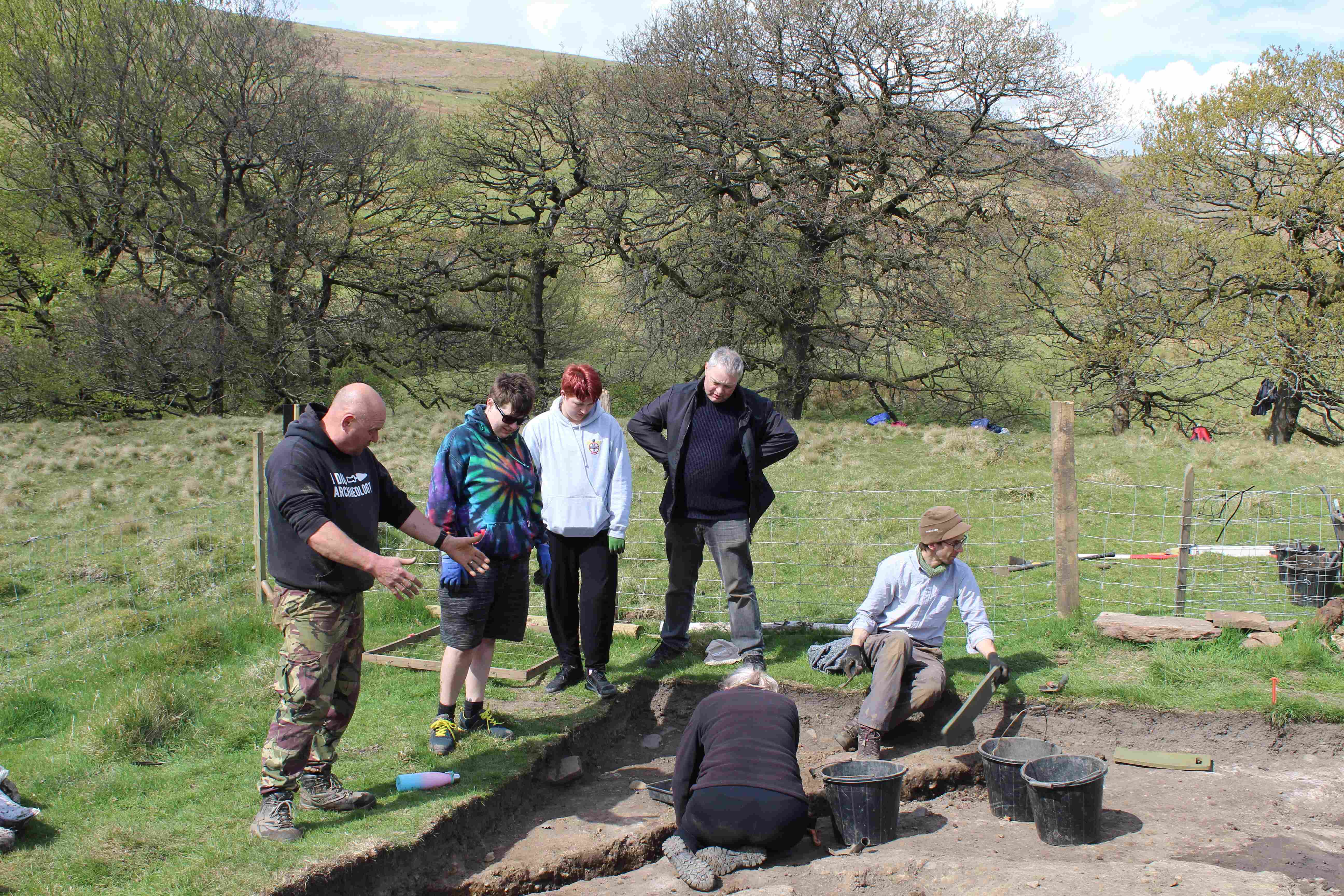
24.4.7
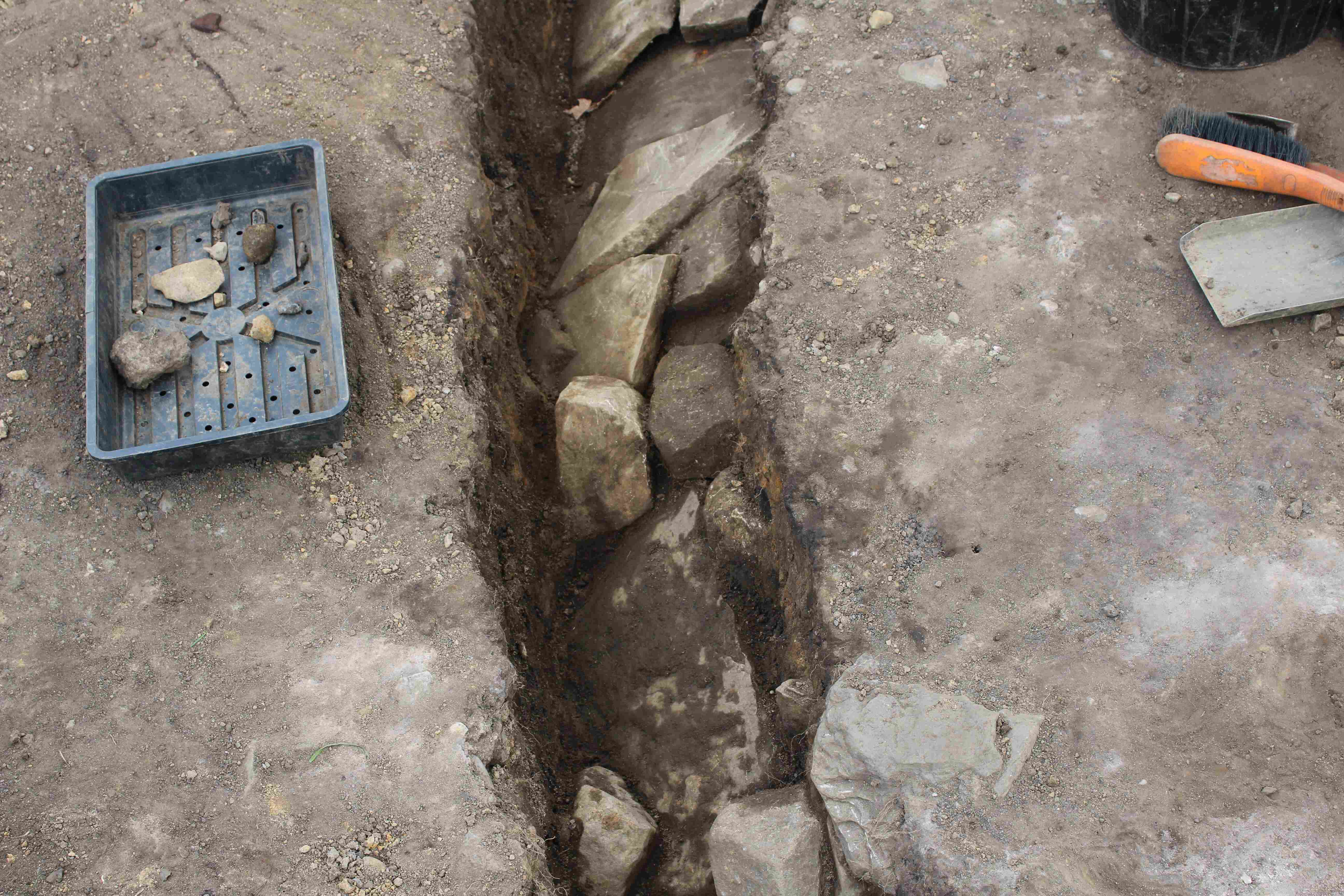
24.4.8
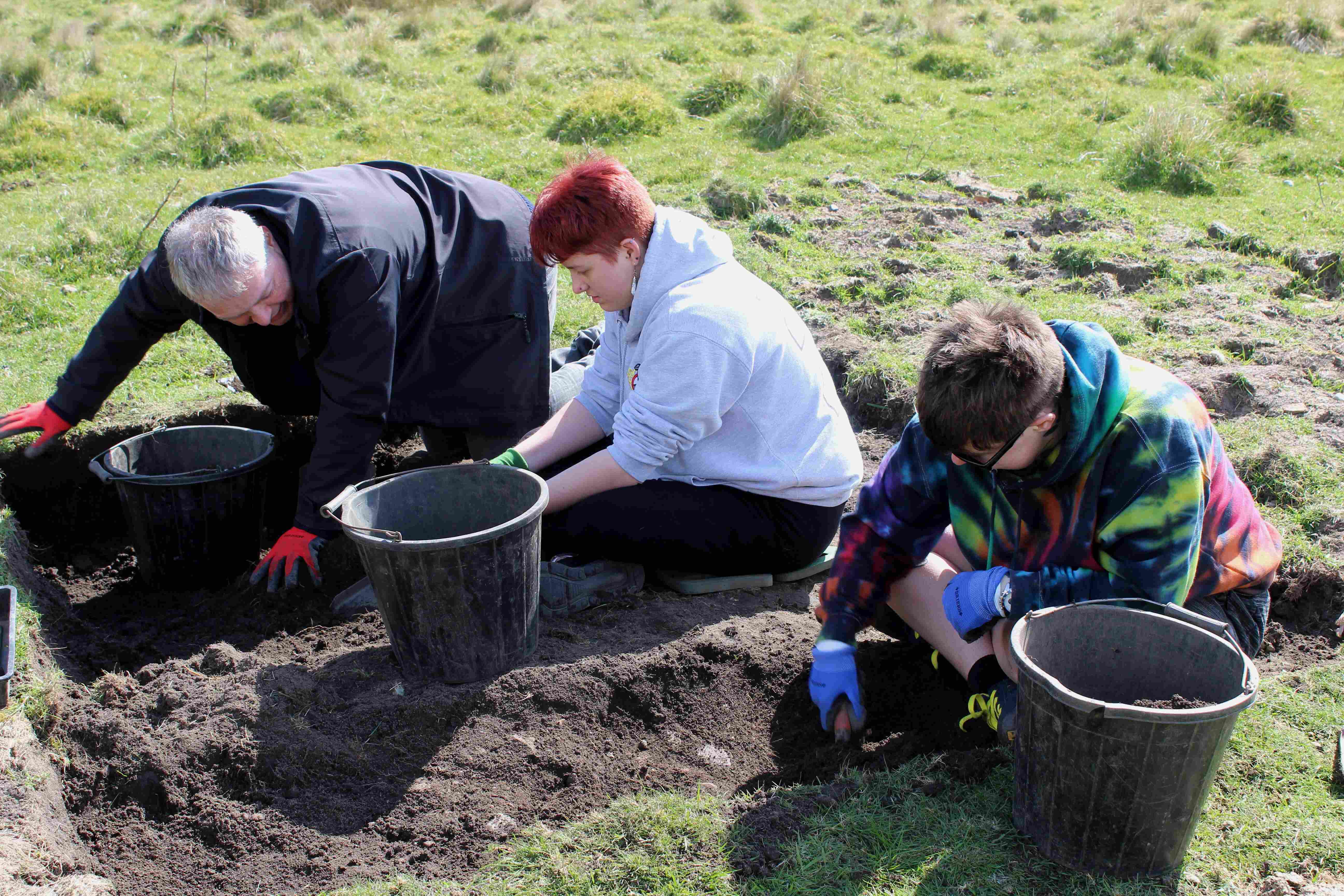
24.4.9
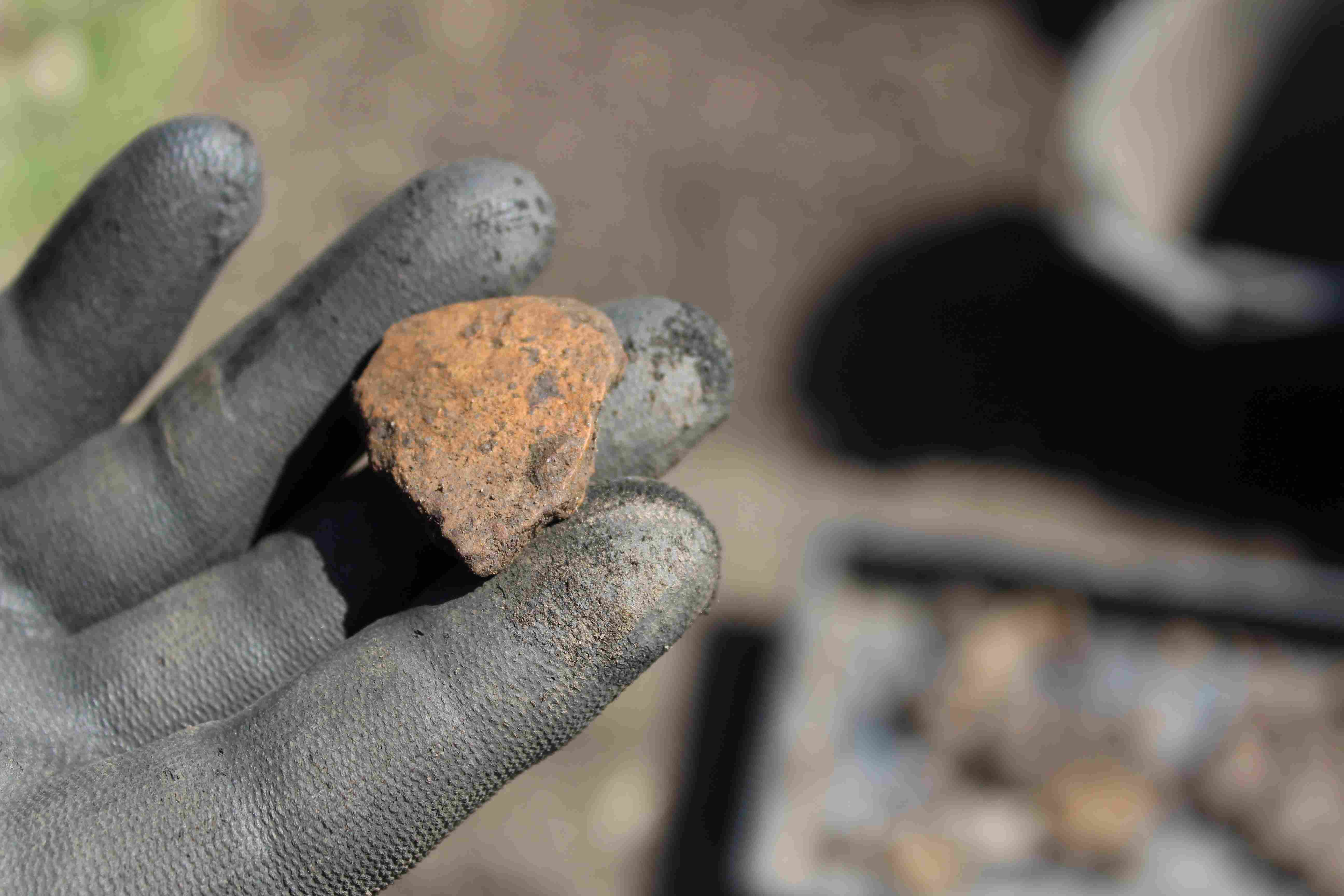
24.4.10
2021 Trench 1
The preservation sandbags and plastic sheeting were removed from the pit at the southern end of the trench. As the pit was too wet to carry out any work it was decided to leave it uncovered to dry out.
One of the team started to sketch the bloomery, as this can record more detail than photographs.
2022 Trench 1
Work continued cleaning the arrangement of stones and clay in the southern end of the trench. As the cleaning continued, 4 stones which were barely visible before now showed up quite clearly as being arranged in a semi-circle, and the bases sloping inwards forming a bowl like structure. This is a repetition of the type of construction of the string furnace found near the first bloomery. We are fairly certain, therefore, that this structure is the string furnace worked in conjunction with the bloomery in the 2021 trench 1. There are a number of clumps of clay covering what would be the centre of the string furnace, which will have to be removed before the state of the furnace can be ascertained. It looks as if the clay clumps are just random deposits. Photos 4.28.01 and 4.28.02
2022 Trench 2
Further work was carried out exposing the remainder of the drain covering at the northern end of the trench. The drain was then recorded and photographed before a small section of the cover was removed Photo 4.28.03. From the photo you can see that the drain is not that big and from the damp state of the detritus at the bottom of the drain, is still in working order. Photo 28.04.04
Next scheduled dig Thursday 12th May.
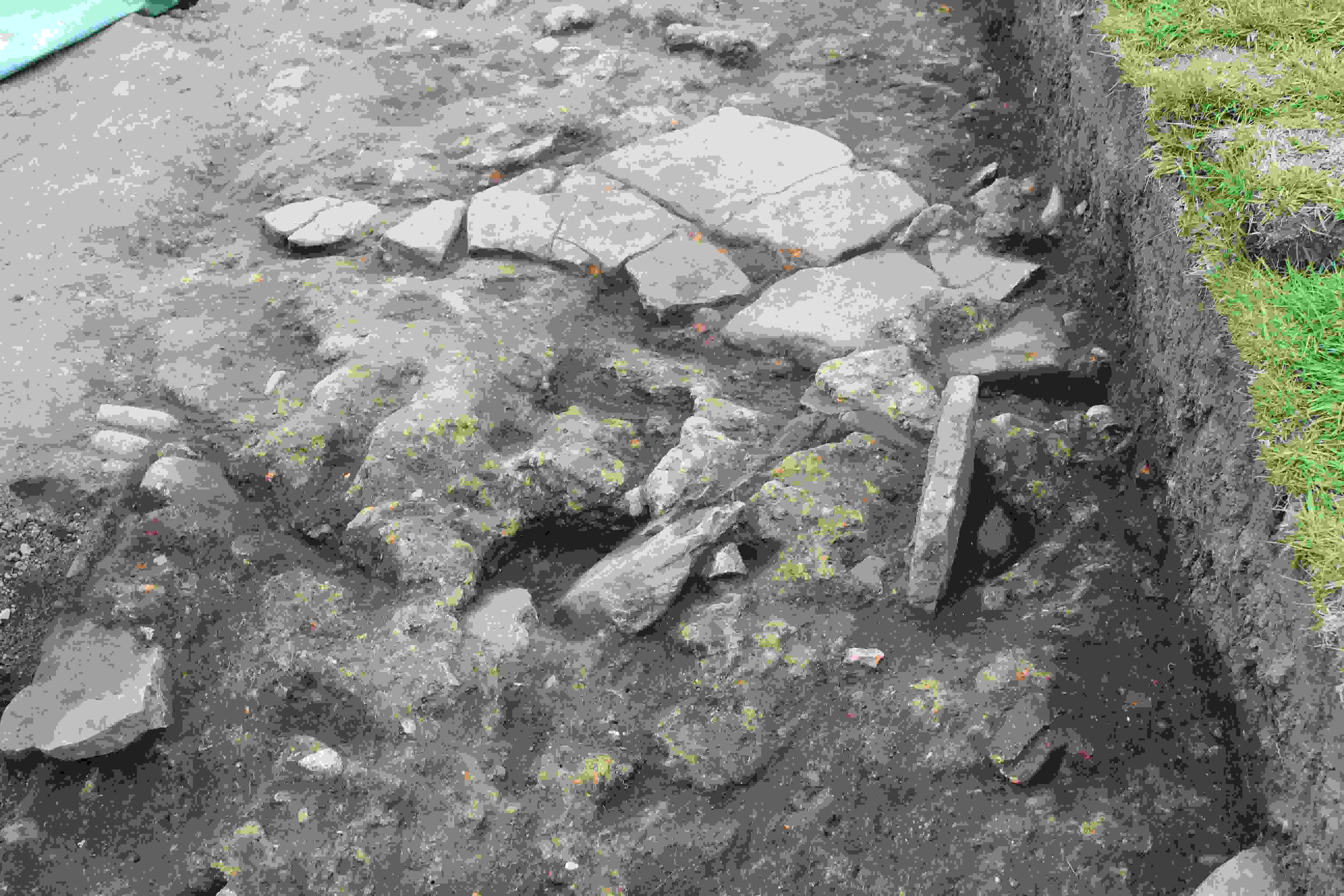
28.4.1
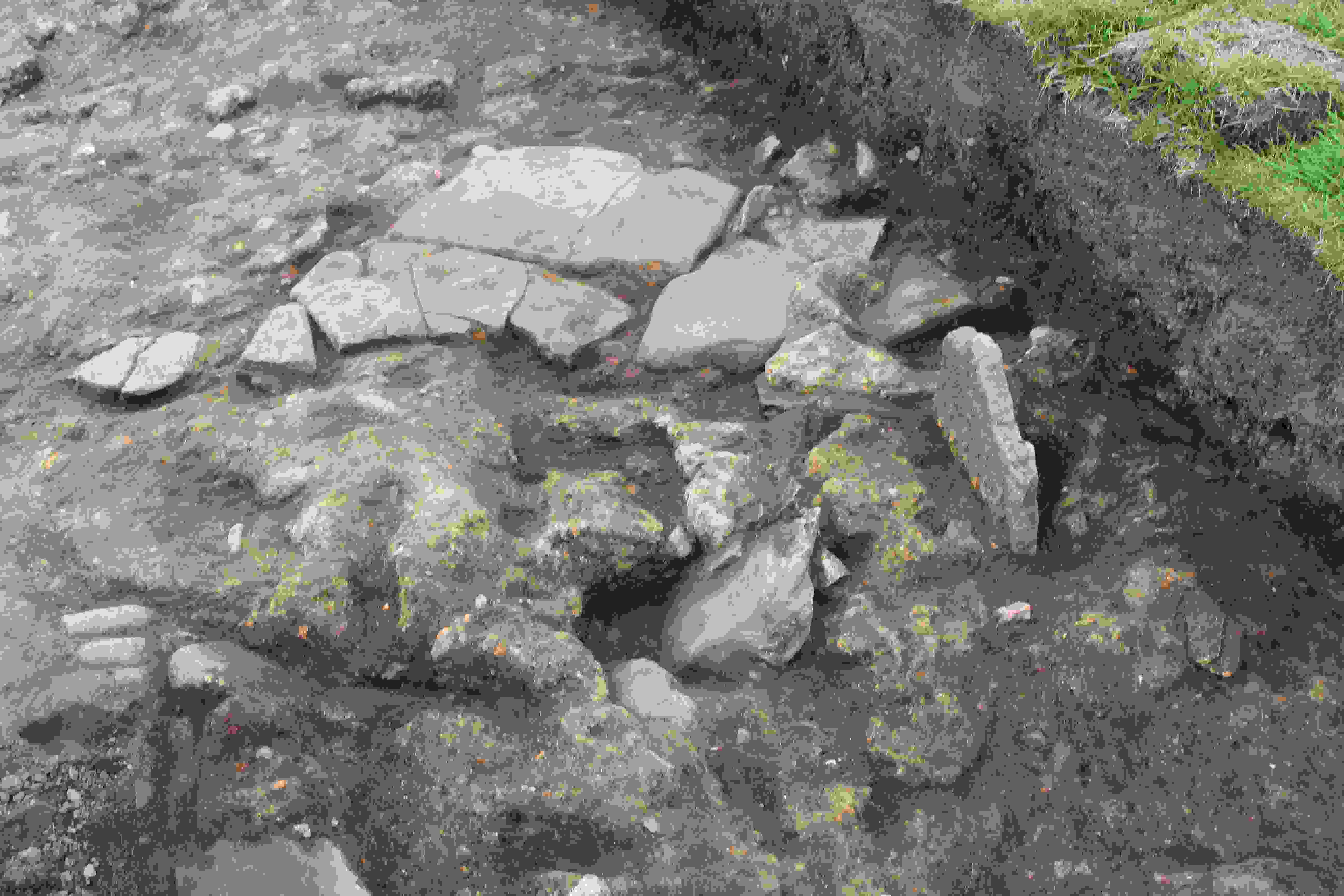
28.4.2
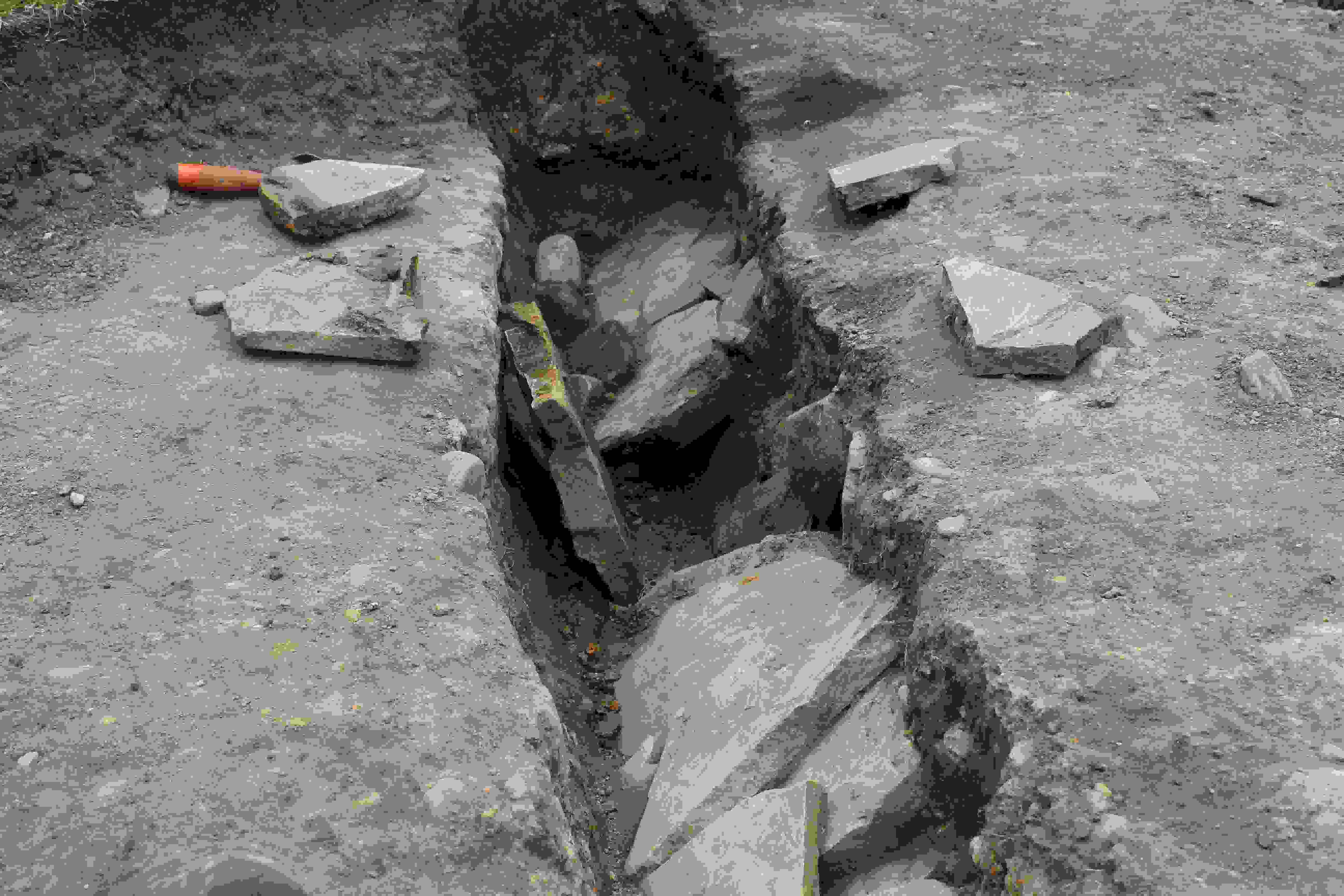
28.4.3
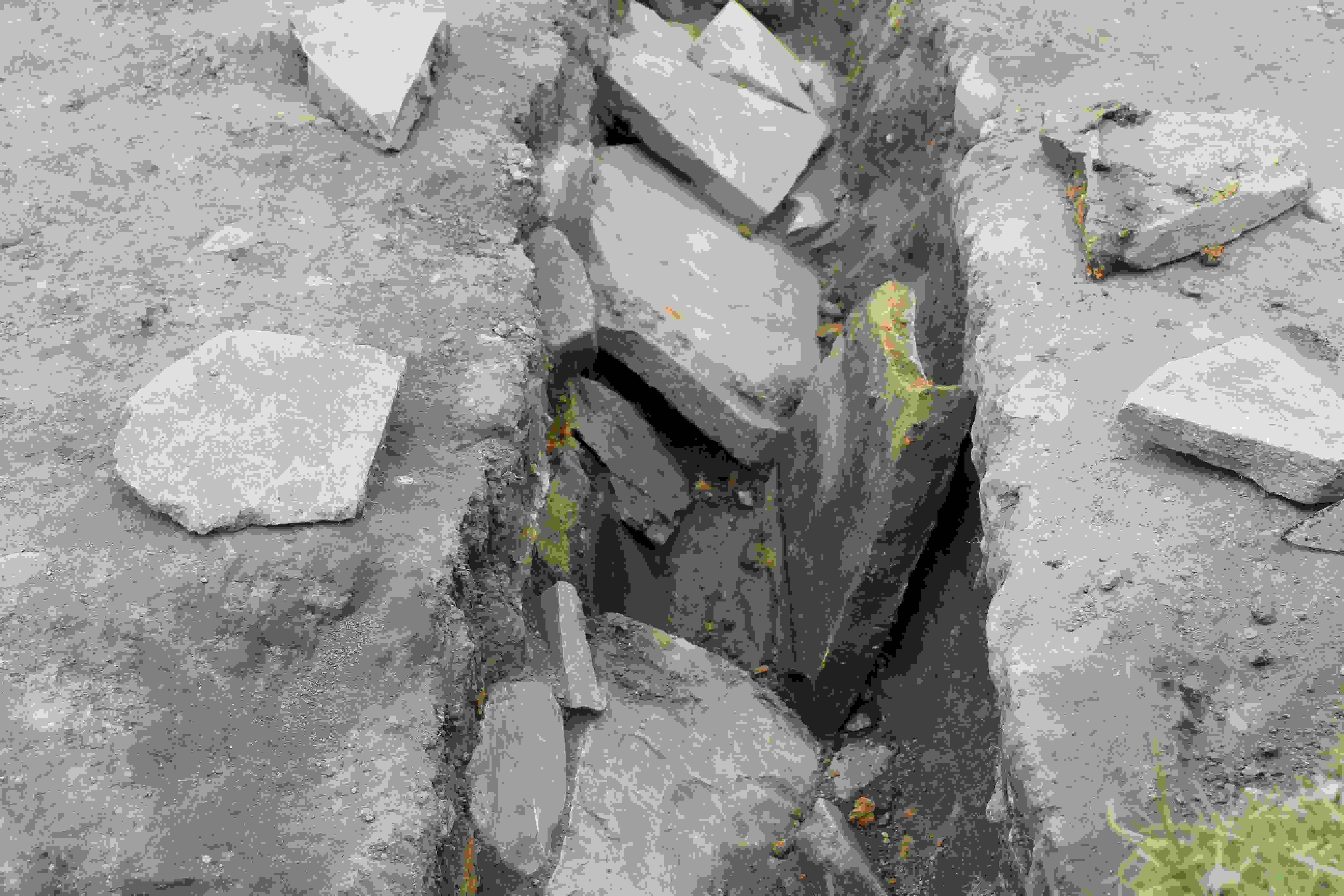
28.4.4
2021 trench 1
As the large pit at the end of the trench circumnavigating the bloomery has been recorded, it was back filled.
2022 trench 1
Work continued removing the layers of clay which exists over the top of what is increasingly looking like a String Hearth. At the end of the day the circular outline of the hearth has become more evident, and an increasing amount of charcoal is beginning to appear. Hopefully, as more of the surface covering is removed from the centre of the hearth, suitable pieces of charcoal will be retrieved which can be sent off for wood type identification and carbon 14 age analysis. Photos 12.05.01 and 12.05.02.
2022 trench 2
Final recording of the drain in the western side of the trench was completed. As there is no further archaeology evident in this trench it is scheduled to be back filled.
2022 trench 3
This trench has been extended eastwards by two meters and de-turfed. The one thing the site is lacking is any sign of habitation; the workforce and the bloomeries must have had some form of shelters to protect them from the elements. To date no signs of any shelters or protective screening in the form of post holes have been uncovered. This trench has been opened to hopefully uncover some evidence of construction. As a lot of medieval pottery sherds have been retrieved from this area so it is hoped it may be an area where some form of structure may have existed.
2022 trench 4 (New)
This 3 metre X 3 metre trench has been opened on the highest area of Cinder Hill, to the north east of 2021 trench 1. Currently there are no theories as to what may lie under the surface, hopefully it will be something more interesting than a pile of slag.
The next dig is programmed for Saturday 21st and Sunday 22nd May
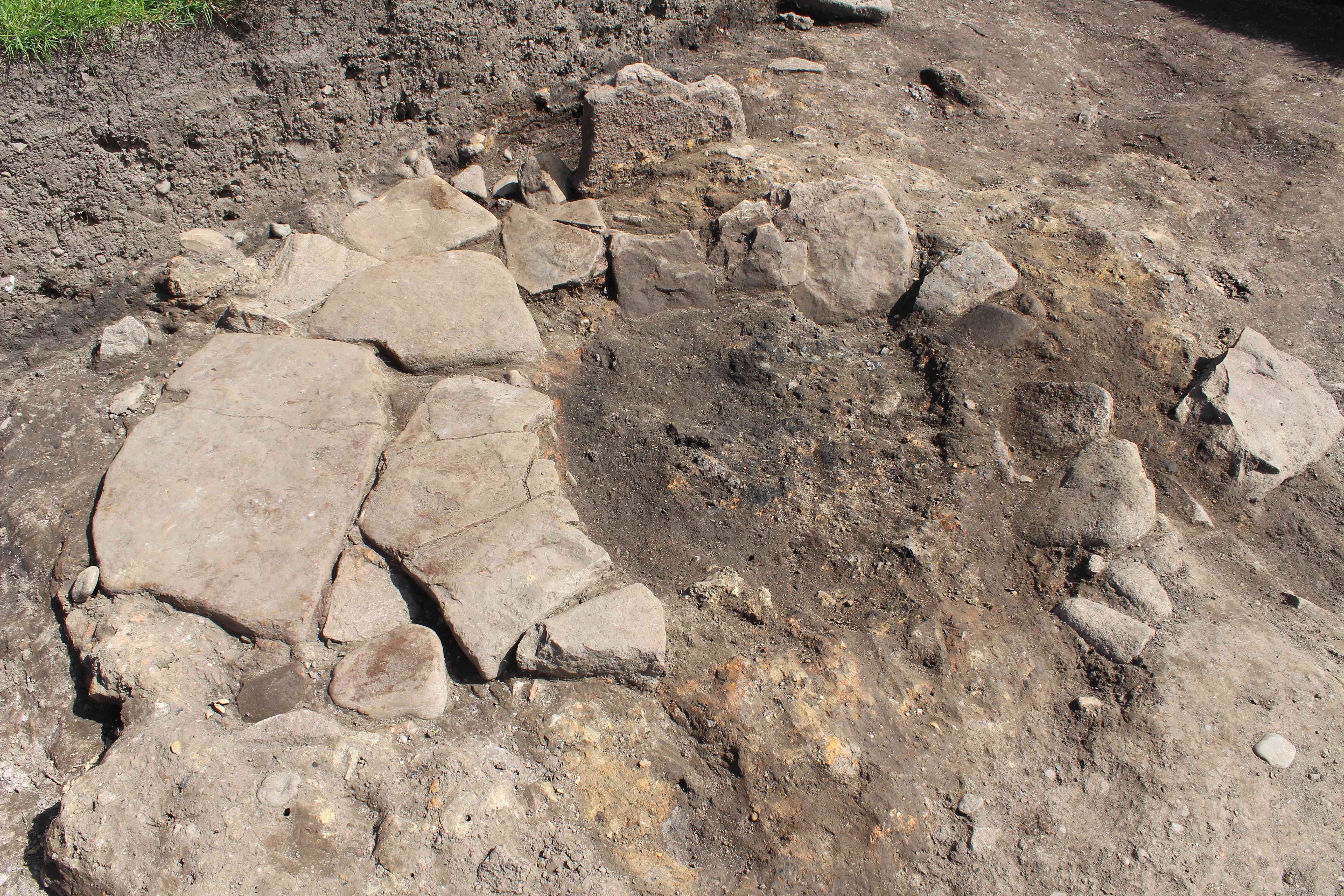
12.05.01
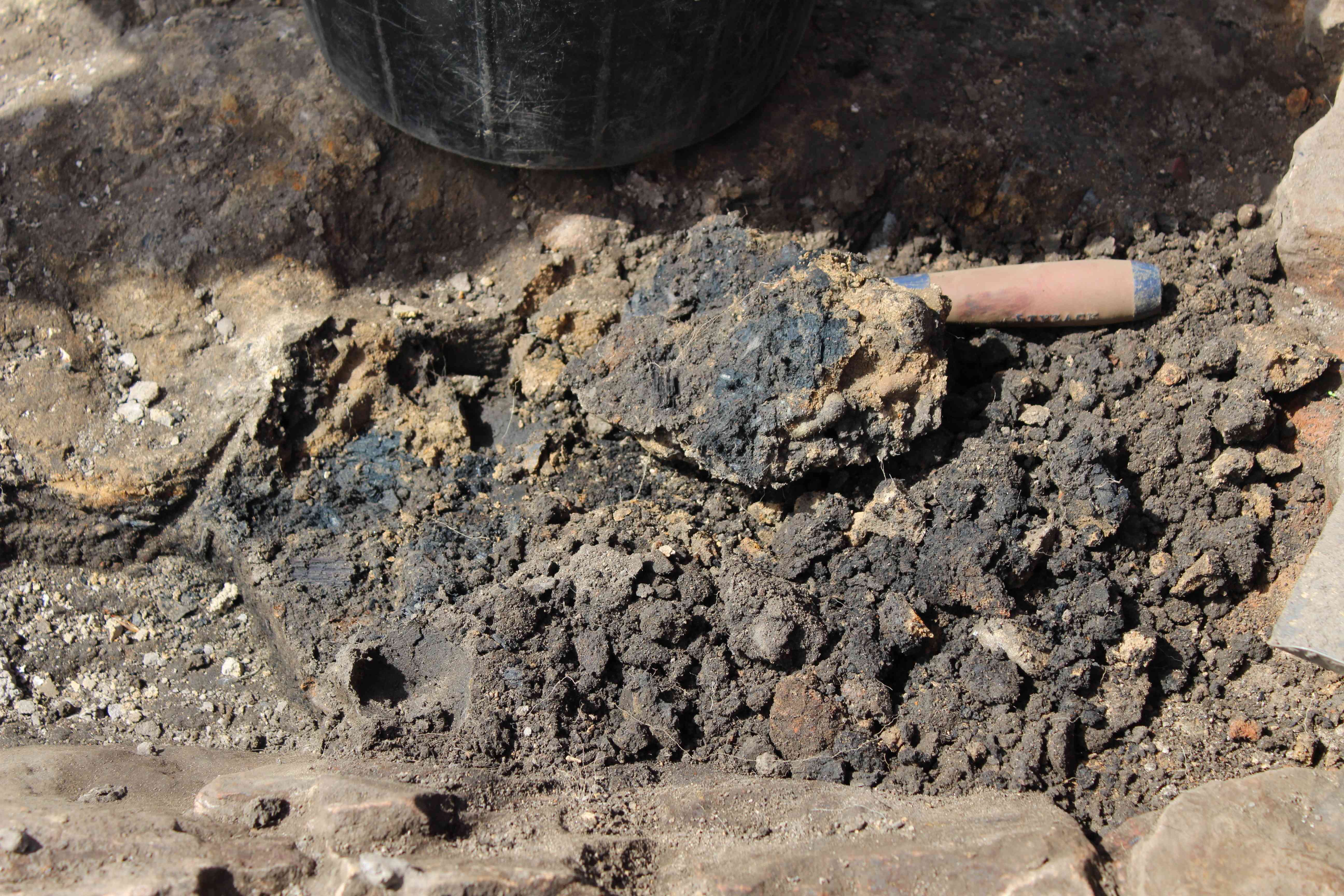
12.05.02
2021 Trench 1
Work commenced cleaning up the bloomery to enable a series of photos to be taken prior to backfilling it. Unfortunately, due to persistent light rain showers, the work had to be curtailed and the bloomery covered to protect the cleaning that had been completed. Photo 01.09.22. Hopefully, if the weather co-operates on the dig weekend of the 18th and 19th June, this work will be completed and the bloomery can be mothballed.
2022 Trench 1
Cleaning of the string hearth continued with the removal of soil to the south of the hearth. Photo 02.09.22
While cleaning the internal south face of the hearth a negative feature was revealed between two stones. Speculation was that this could have been a tuyère where a set of bellows would force air into the hearth. After cleaning the hole it was found to deviate to the right and it did not pass through the wall of the hearth, which means it could not be a tuyère. After much head scratching the conclusion reached was that this is yet another mole hole. This is not the first time that moles have led us down the rabbit hole on this site. Photo 03.09.22.
In 2021 a large, circular clump of compacted slag was uncovered close to the string hearth. From the shape and size of this circular piece of slag there is a very strong probability (90%) that it came from this hearth.
2022 Trench 3
Work continued removing the topsoil from the southern sector of the trench; in the process two features were uncovered. One, on the eastern face, is a collection of stones which initially gave the impression of more extensive finds under the topsoil. Unfortunately, as work progressed the collection of stones appeared to be just a random deposit. Photo 03.09.22. Towards the west end of the trench a roughly circular deposit of fine red coloured grit was uncovered, which would appear to be a random deposit and not a domestic hearth. Photo 04.06.22. Oh, and we found mole holes and tunnels in this trench as well.
The next digs are scheduled for Saturday 18th and Sunday 19th June, weather and army requirements permitting.
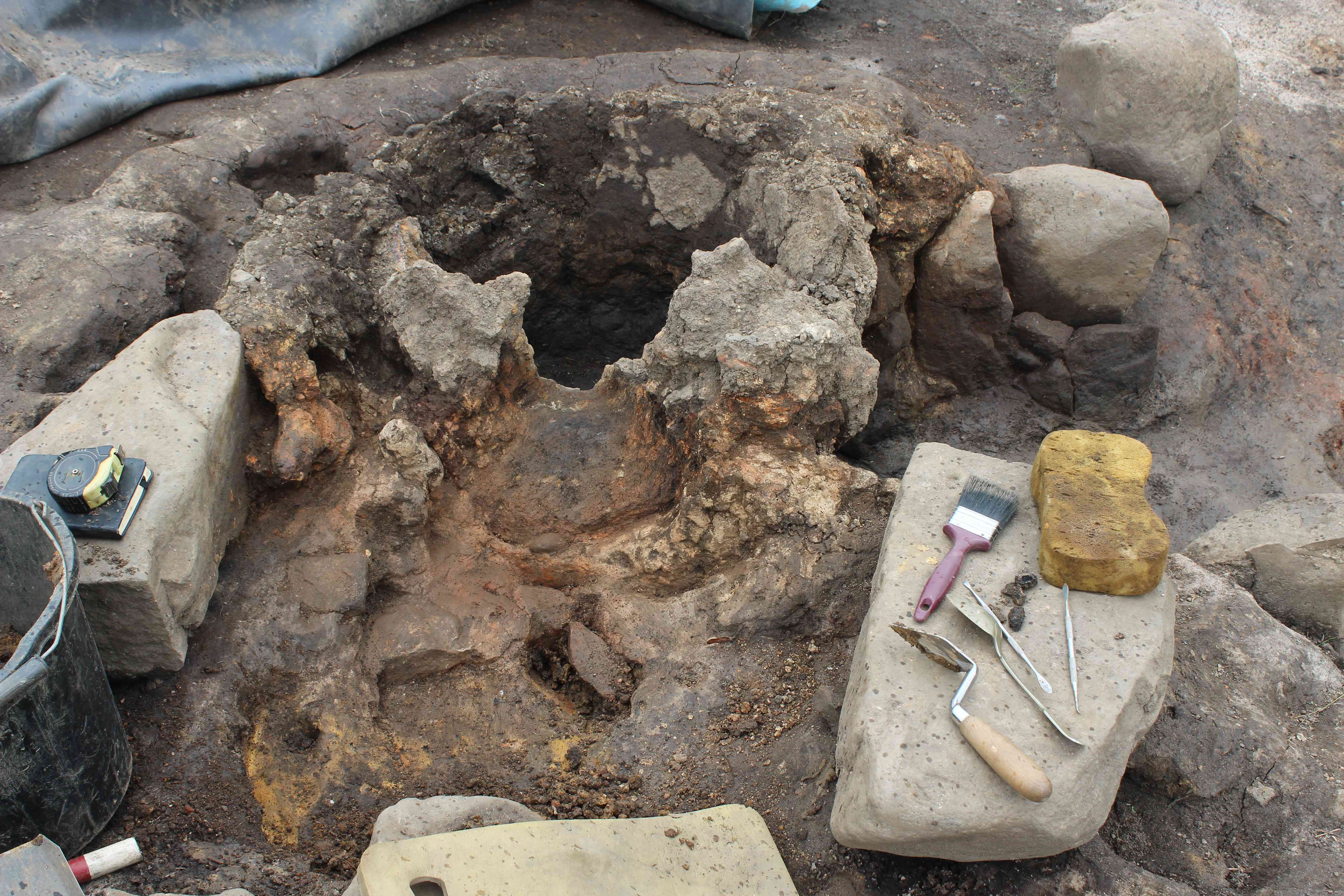
01.09.22
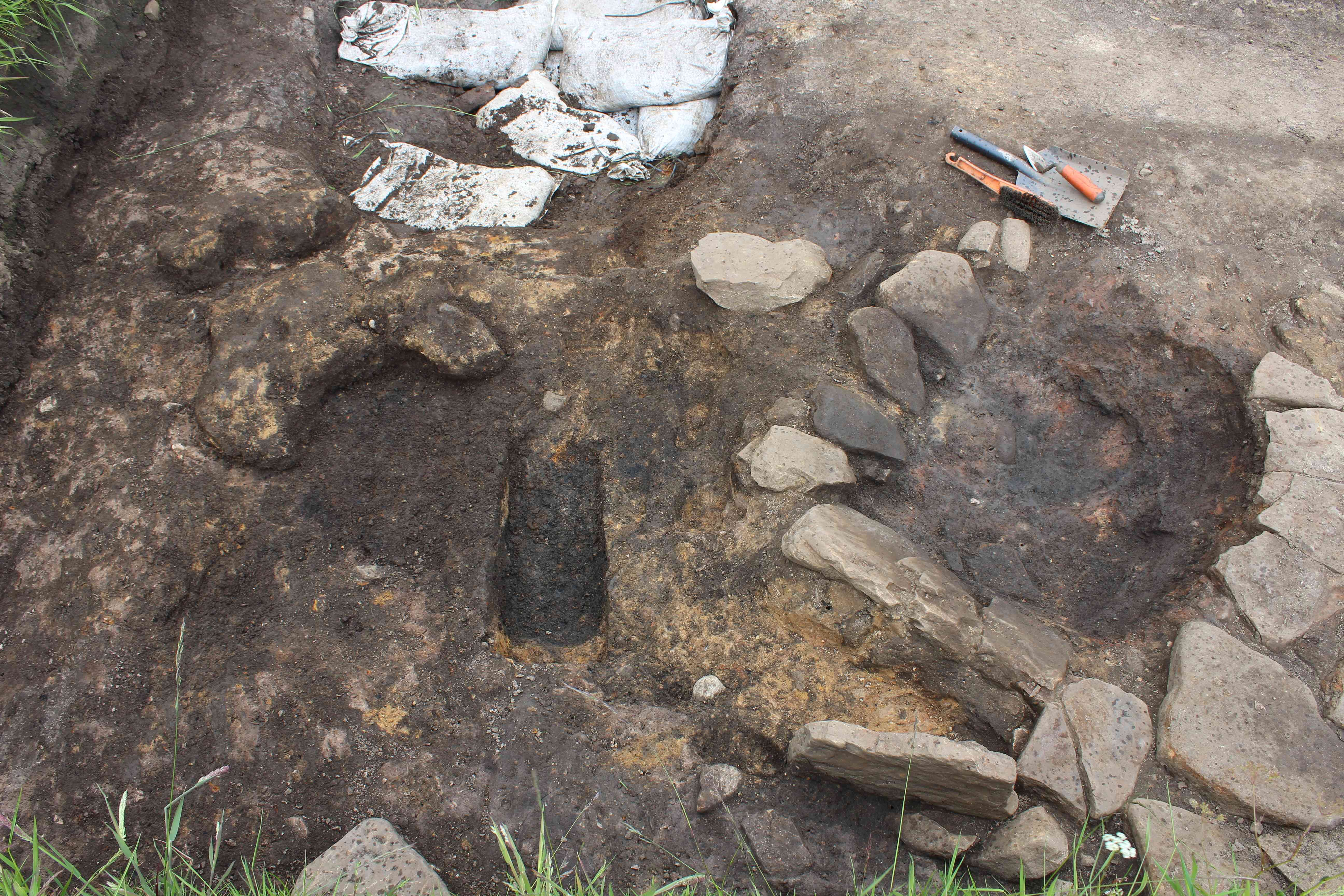
02.09.22
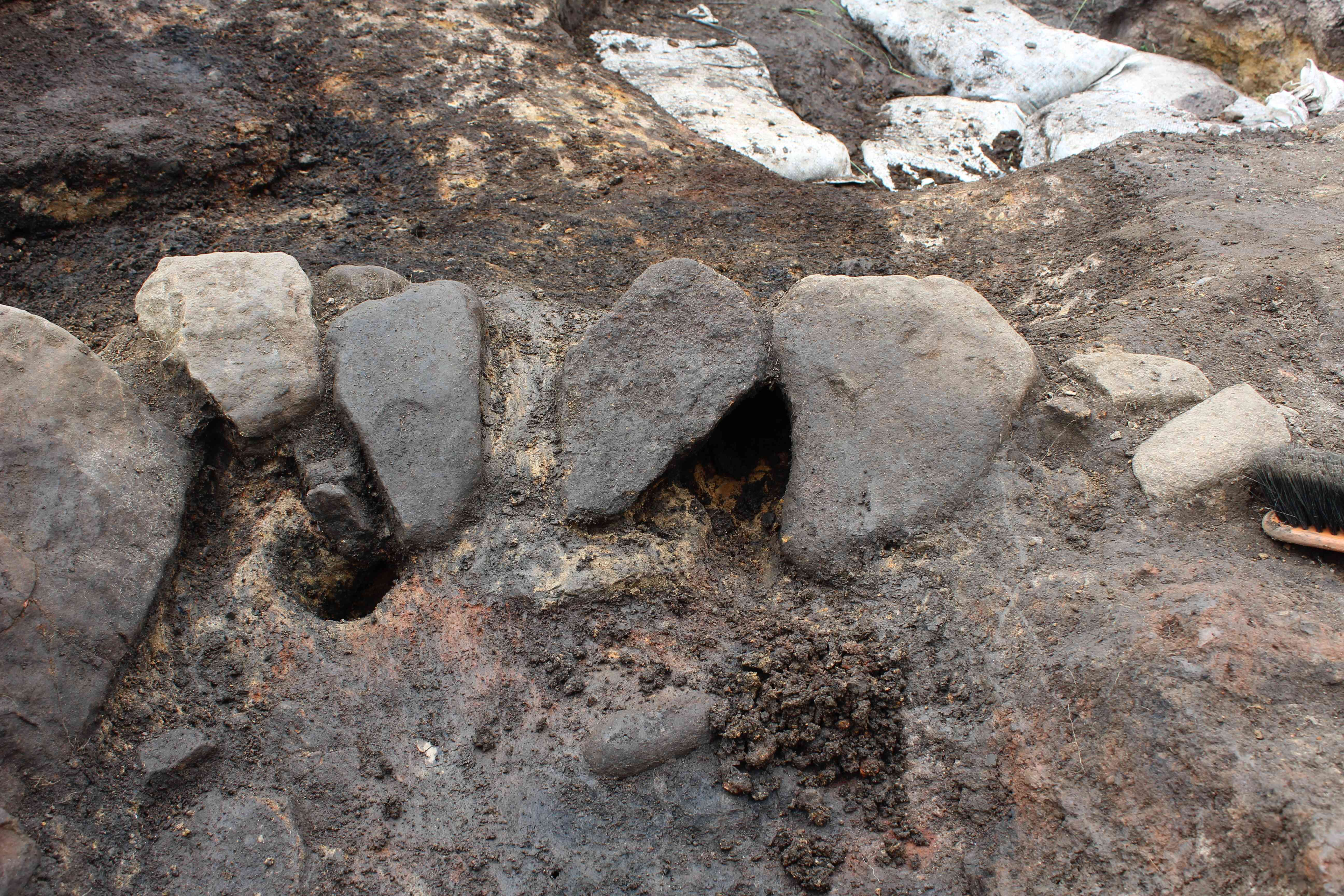
03.09.22
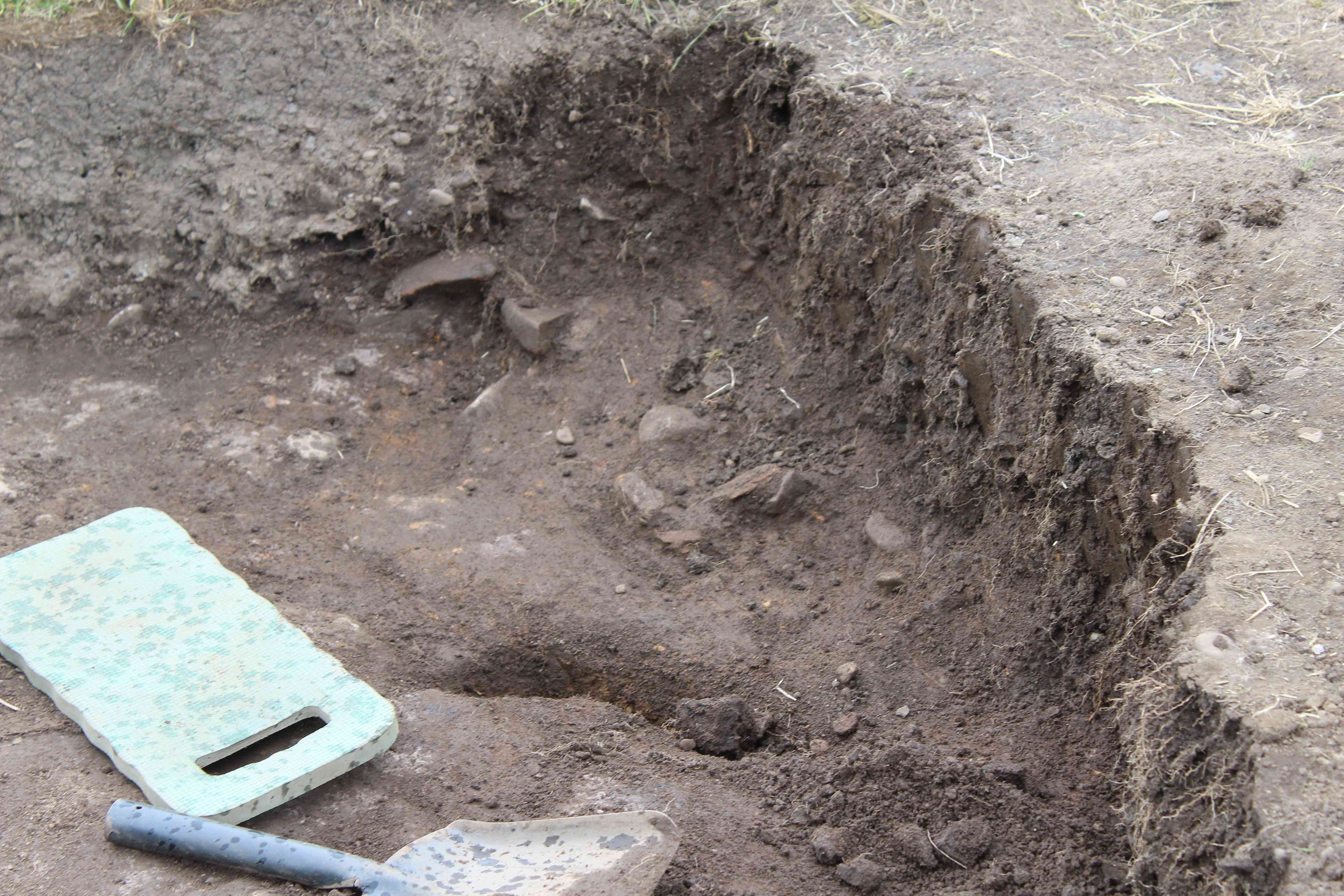
04.09.22
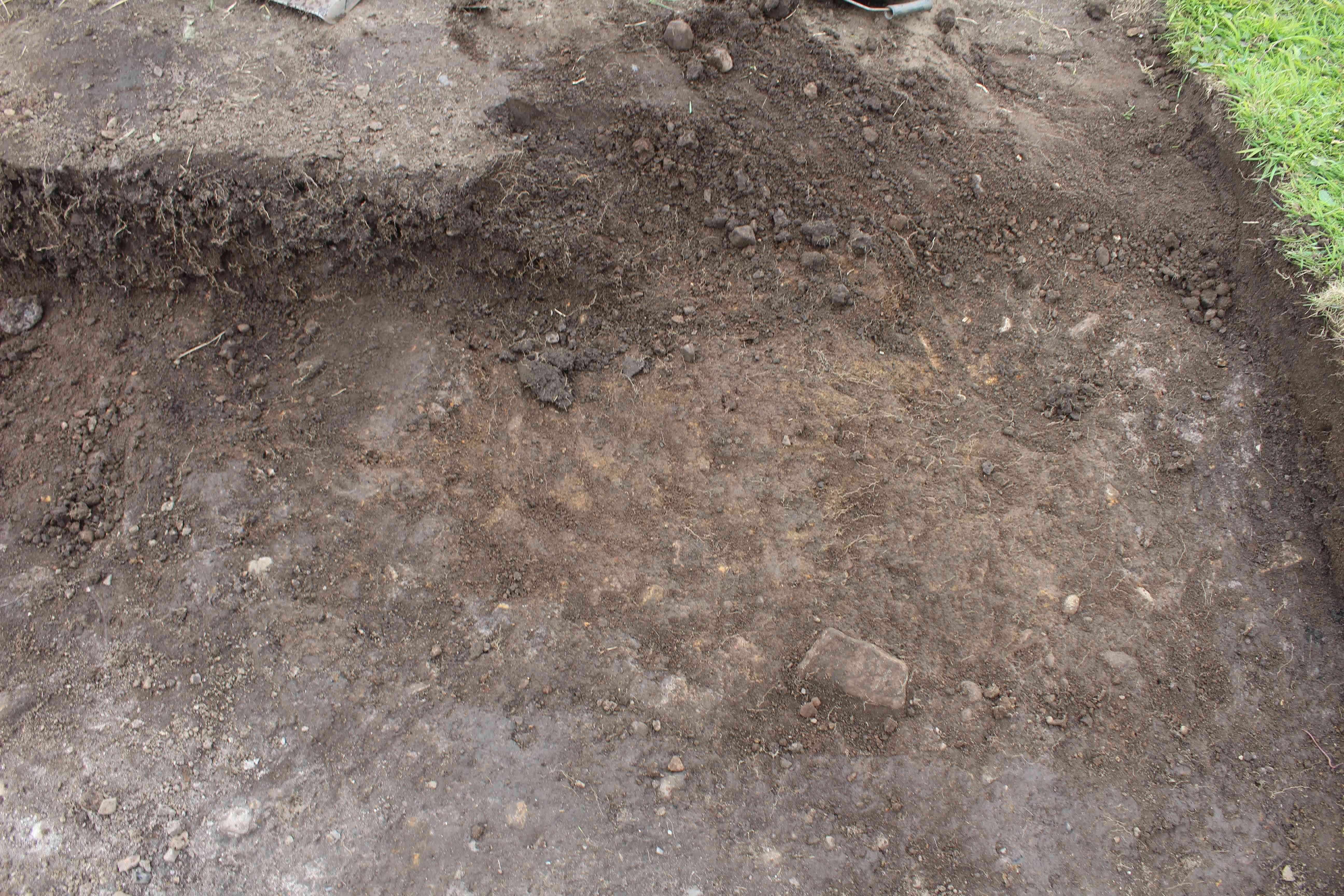
05.09.22
2021 Trench 1
Work was completed cleaning up the bloomery. A series of high-definition photos was then taken of the bloomery tracking through 360 degrees as well as downward facing photos. These photos will be put into a computer programme which will produce a very detailed 3D photo of the whole bloomery viewed from many angles. The overall results are very impressive and will go a long way to documenting the bloomery for future studies.
Photos 1.19.06 and 2.19.06
There is still a certain amount of recording to carry out on the bloomery, after which it will be closed down.
2022 Trench 1
Work continued cleaning the southern aspect of the String Hearth. Some very interesting circular negative features were uncovered which, after cleaning, revealed that the moles had struck again. Photo 3.19.06. Mole tunnel hole diameters are in the region of 2 inches, which fits reasonably well with the existing holes. What is interesting, is the even distribution of the holes with respect to each other. It is this regularity which produces just a small doubt as to whether they are mole holes.
A series of high-definition photos were also taken of the hearth to produce a 3D display.
2022 Trench 3
If the army was carrying out the excavation this would be the jankers punishment. A lot of hard work has gone into removing the topsoil of this trench with very little reward. Finds to date have been very few and far between. Work on Sunday concentrated on excavating the western side of the trench down to the light grey clay base. Now this has been accomplished it will be easier to clear the trench in an easterly direction as a reference level has been established. Photo 4.19.06.
2022 Trench 4
The remainder of the topsoil was removed from the southern section of the trench. The southwestern area of the trench has a light grey clay base, while the eastern section consists of orange clay. One very interesting discovery made in the orange clay section was a post hole. Photo 5.19.22. This has proved to be a very important find as this is the first indication of a structure that has been uncovered on the site. Evidence of domestic type structures on bloomery sites are very rare, so if it can be proven that a structure existed on this site, it will make the site very important. It will now be a case of trying to locate additional post holes to determine if a structure existed, and its size.
During the previous dig a negative feature was uncovered in the northeast corner of the trench. In order to investigate this feature further it was necessary to open a 1 x 1metre trench in the northeast corner. During the excavations a couple of sherds of gritty ware pot were recovered. Photo 6.19.06. Unfortunately, at the end of the excavation, the feature proved inconclusive. Photo 7.19.06
Drain source investigations
There is a covered triangular constructed drain running northwest to northeast through the site which has been uncovered in various trenches. What has not been determined is the start of the drain, so it was decided to open a 1 x 1 metre trench just to the west of trench 2022 4. As luck would have it, the trench reached a compacted section of clay which appeared to be the start of the trench, although there were no stones forming the drain walls. It was necessary to open a ½ metre square trench adjoining the southwest corner of the first trench to uncover the drain stonework. A bit more work will be required at the next dig to expose the end of the drain. Photo 8.19.06
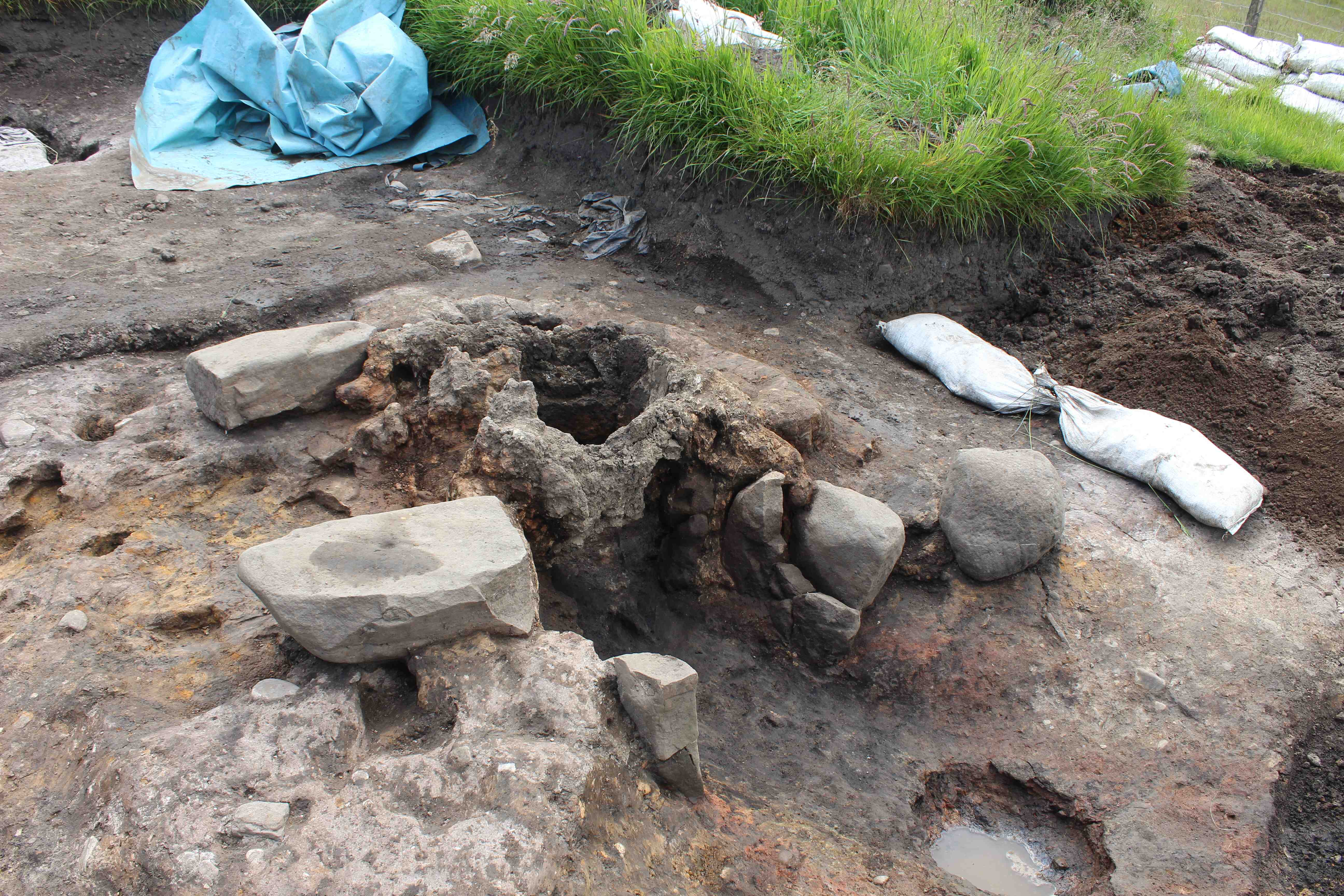
01.19.22
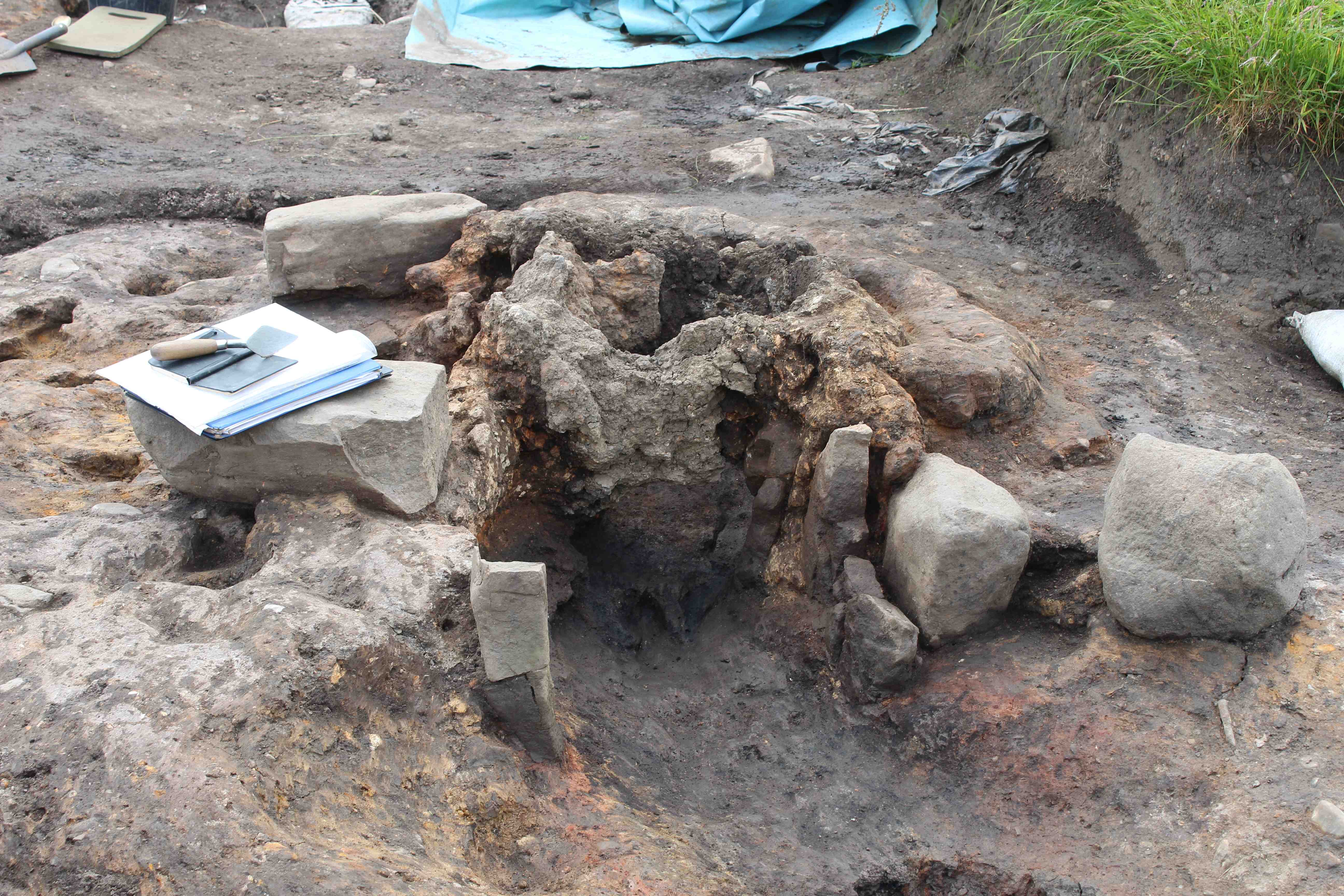
02.19.22
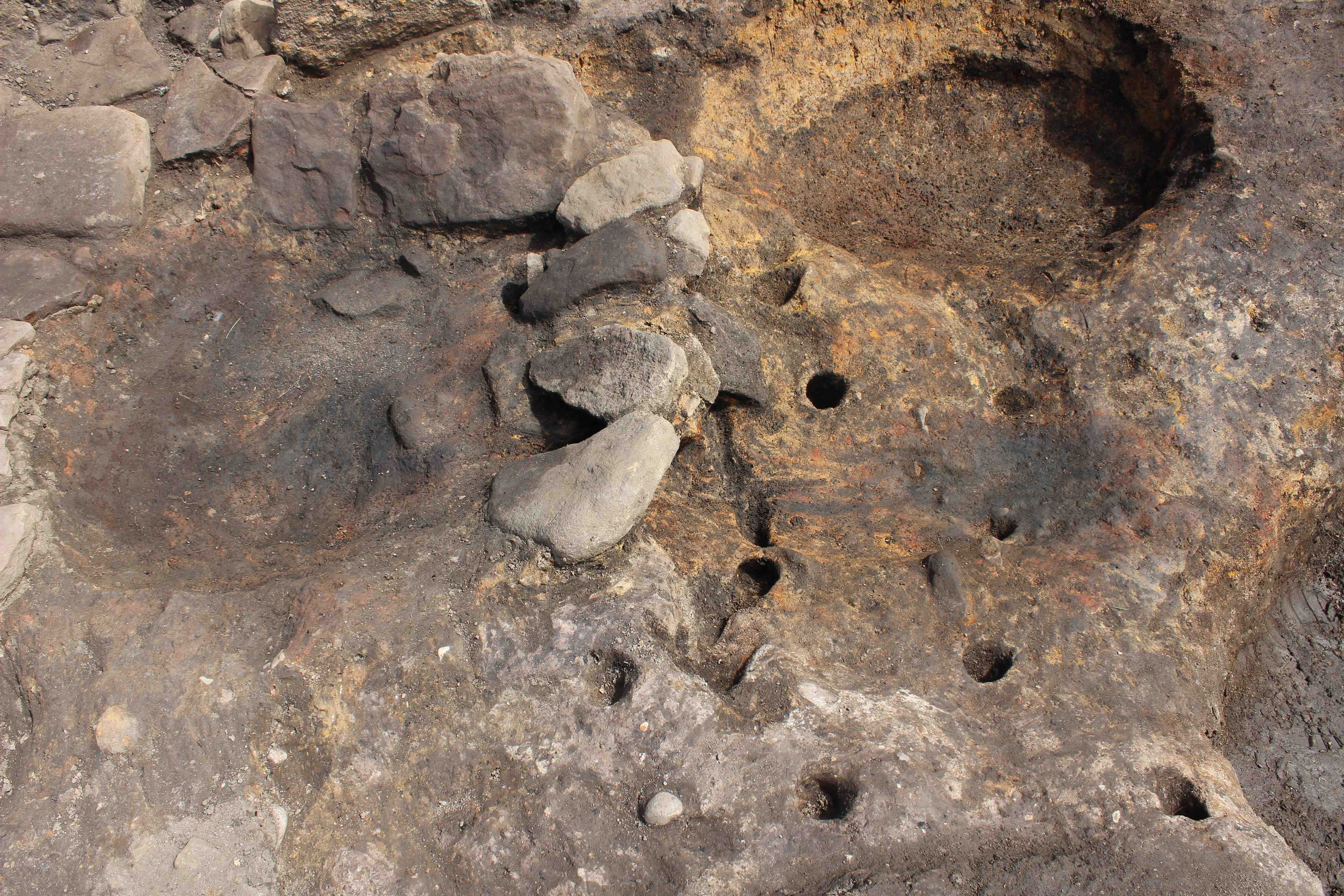
03.19.22
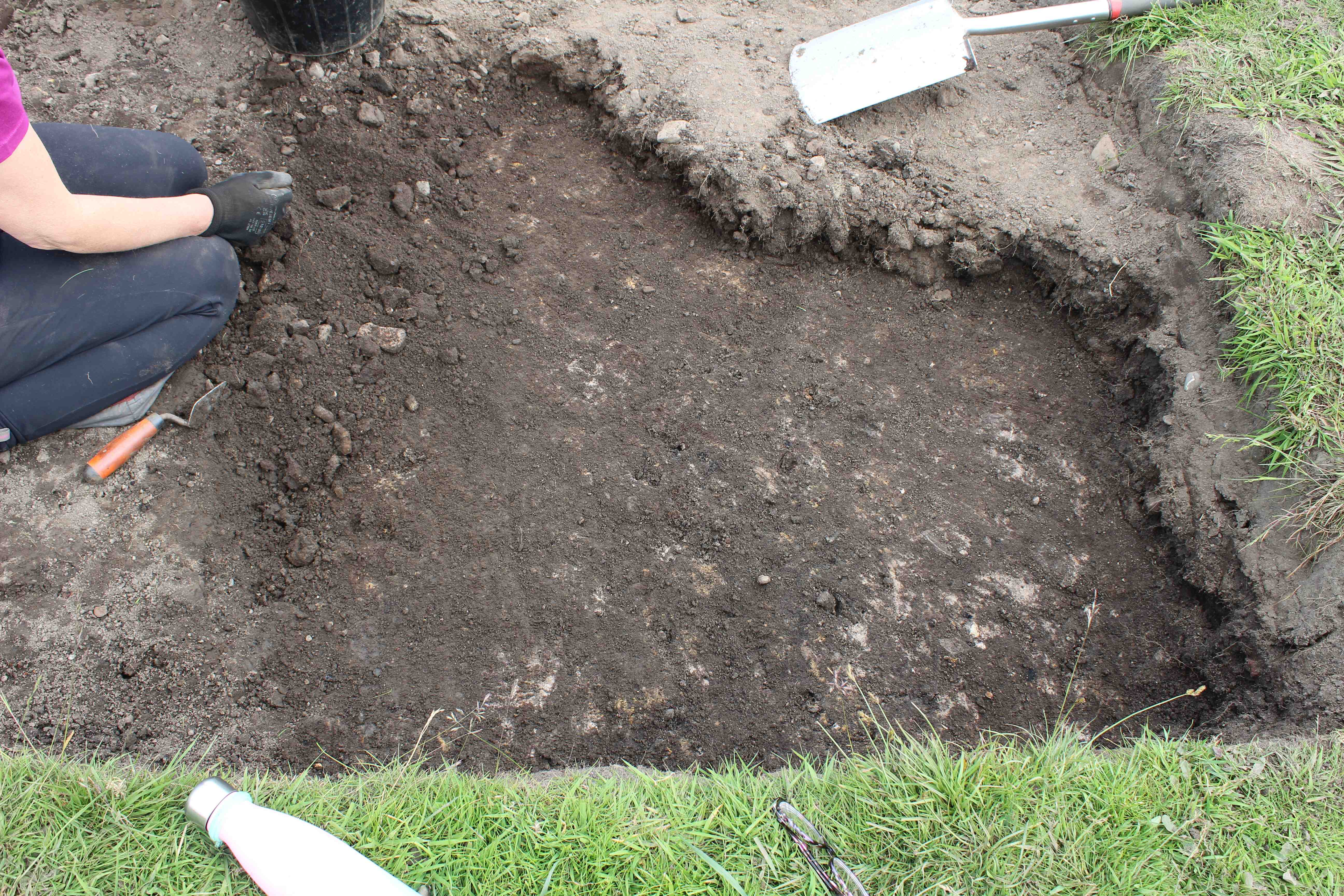
04.19.44
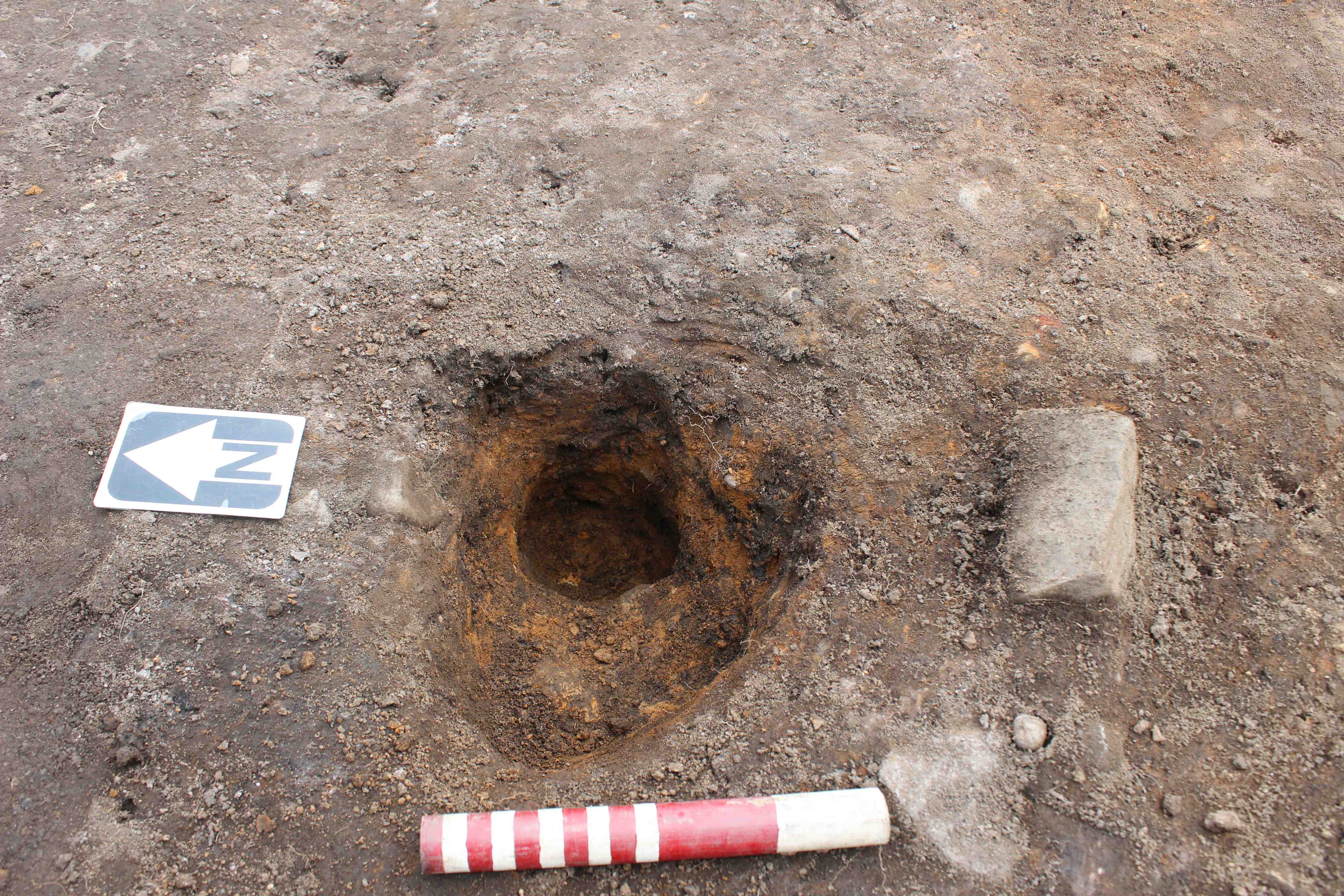
05.19.22
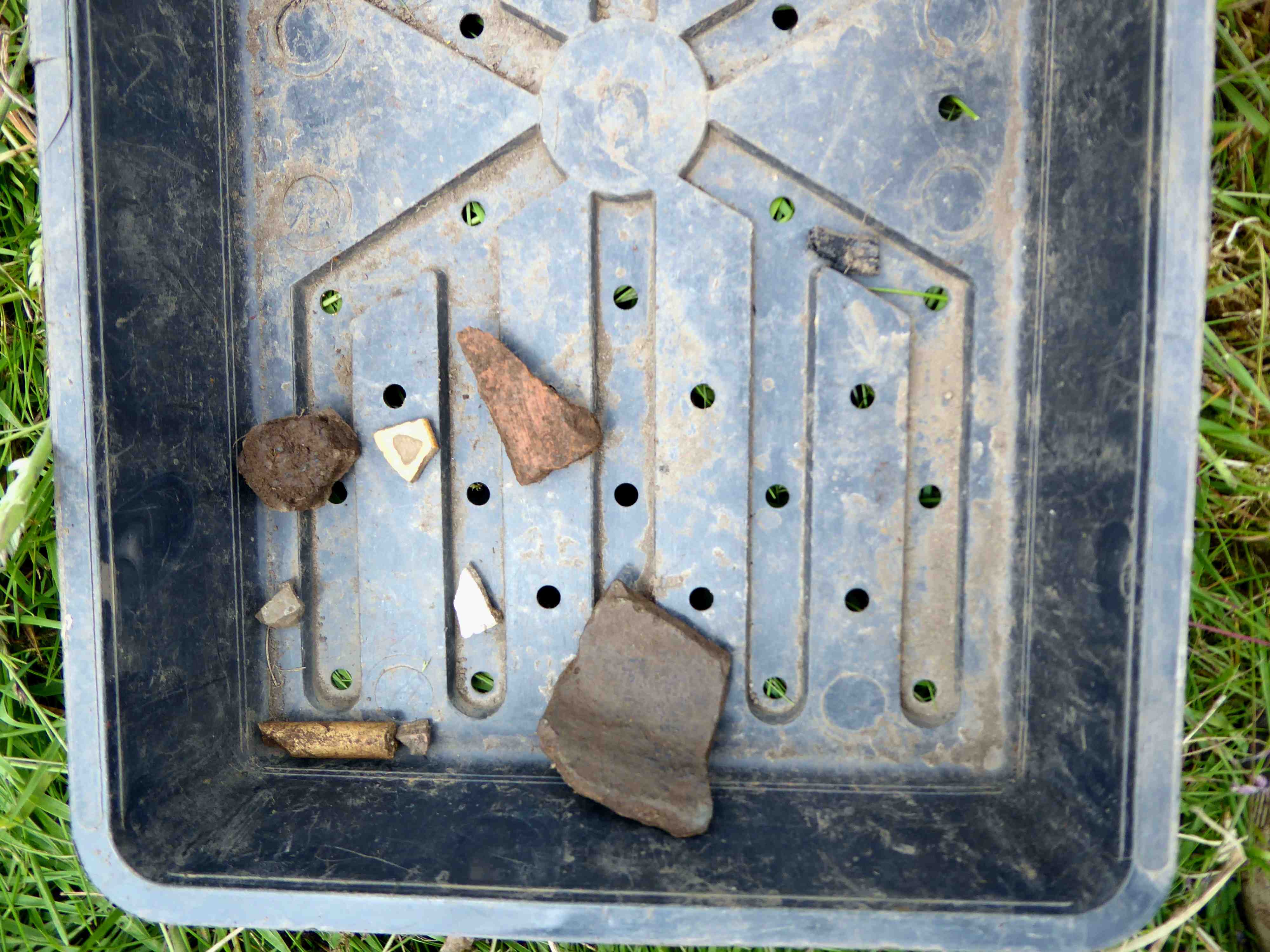
06.19.22
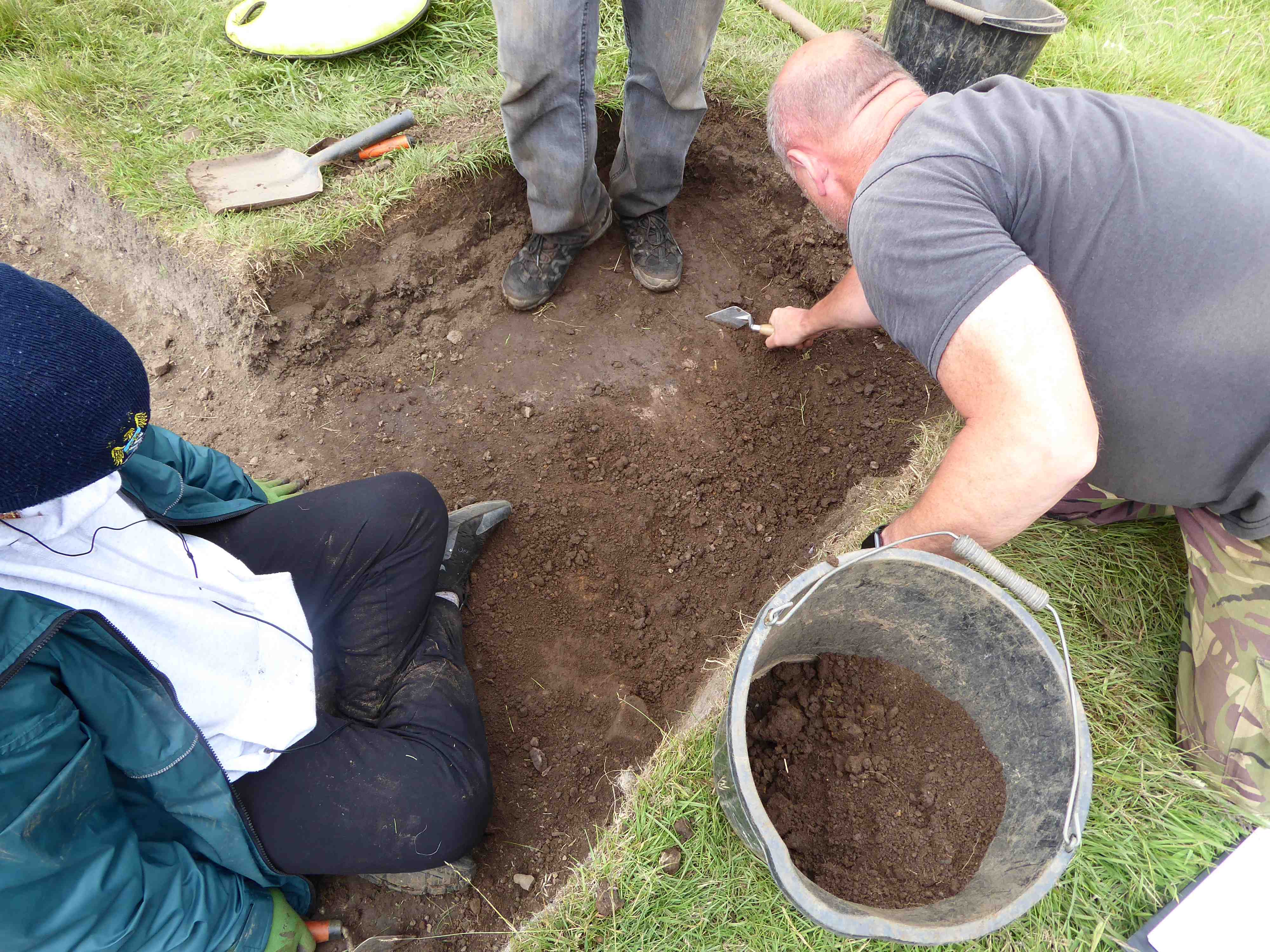
07.19.22
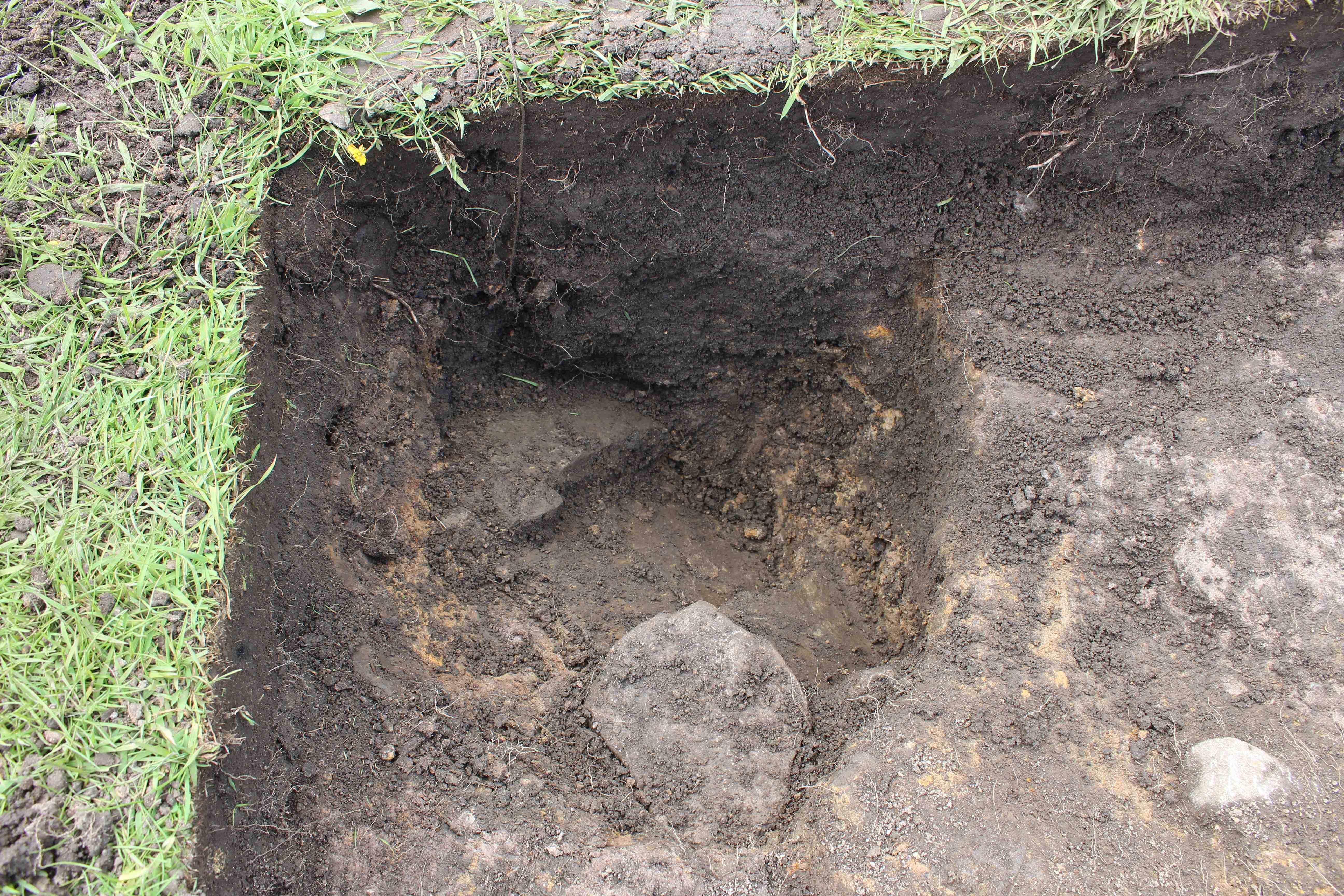
08.19.22